IFA 2013 with your own eyes: Samsung, Toshiba, Panasonic, TCL / Alcatel and Archos mobile devices
On my first day at IFA 2013, I naturally rushed to the Samsung booth, where for the first time Europeans were shown and allowed to hold the Galaxy Note 3 smartphone in their hands. On the same day, I got acquainted with Toshiba and Panasonic tablets, TCL / Alcatel and Archos smartphones. With some delay, but still share personal impressions and photos.

Samsung pavilion was expected to be the biggest at IFA 2013, with its own stage and many themed stands. According to my calculations, only Samsung Galaxy Note 3 was put up at least 200 pieces!
')
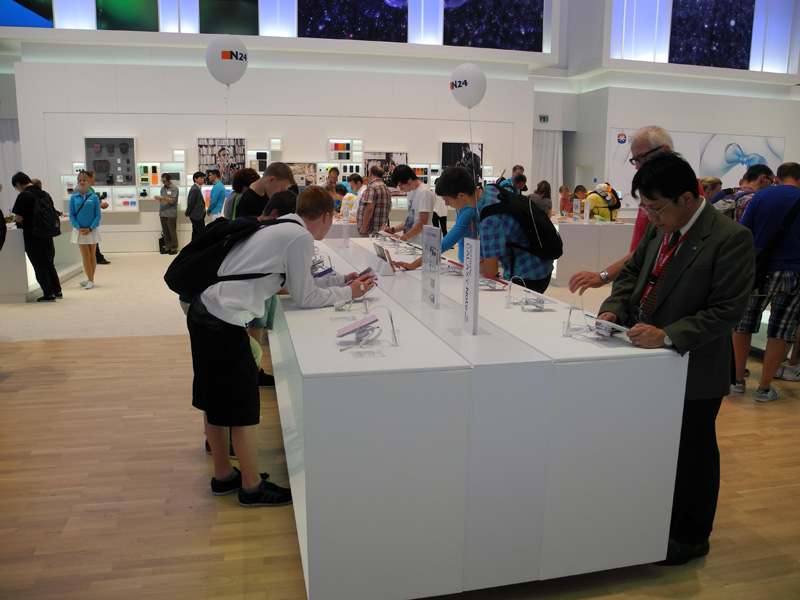
There were a lot of people with these smartphones, but because of the large number of exhibited copies, anyone who wanted could literally immediately hold a novelty in their hands.
And I must say, I liked the device. Workmanship - at a height.
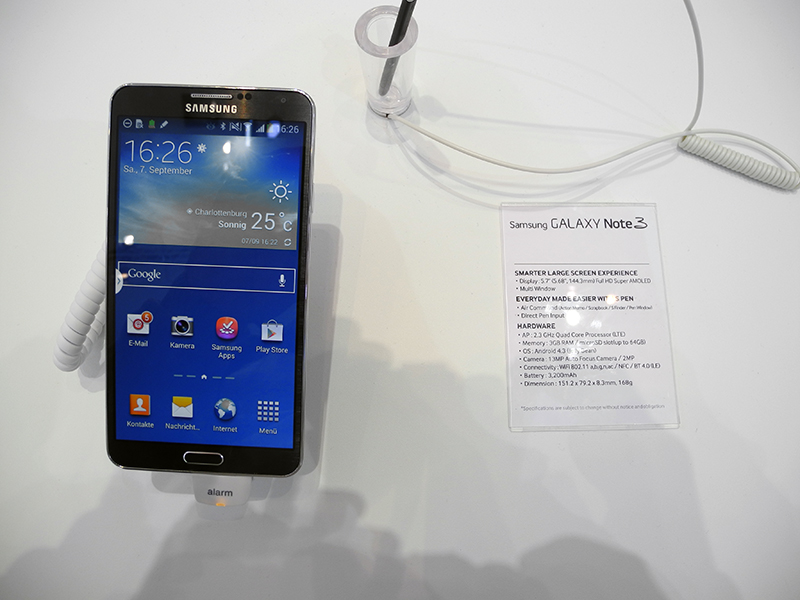
The metal strip around the perimeter is corrugated, apparently, this is done so that the device clings even more to the palm. By the way, I did not experience any discomfort from the size of the smartphone, perhaps because of the considerable size of my hand. But with the Sony Xperia ZU is really really difficult to manage.



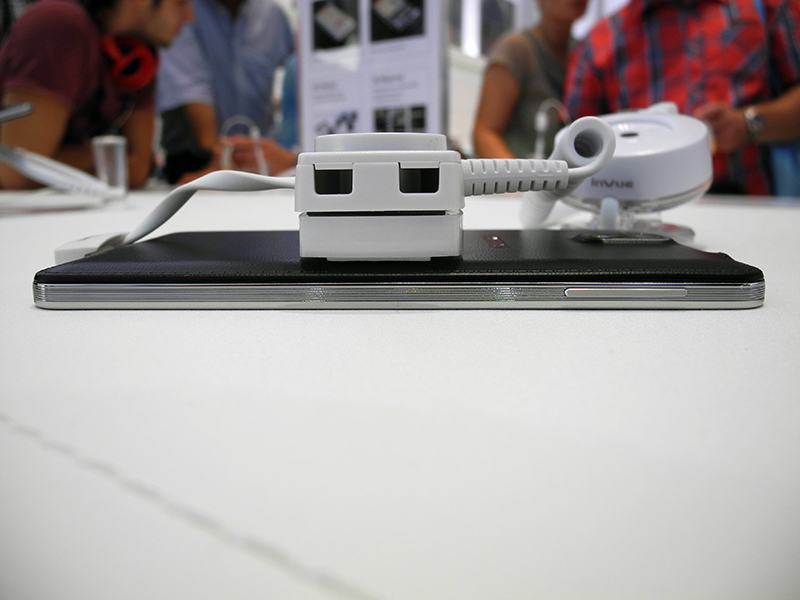



Galaxy Note 3 has several color options, and they differ markedly in the finishing of the front panel. For example, the design of the front panel of the dark gray version gives rise to associations with brushed aluminum, and in the white and pink versions the pattern is already geometric - diamonds with stripes.
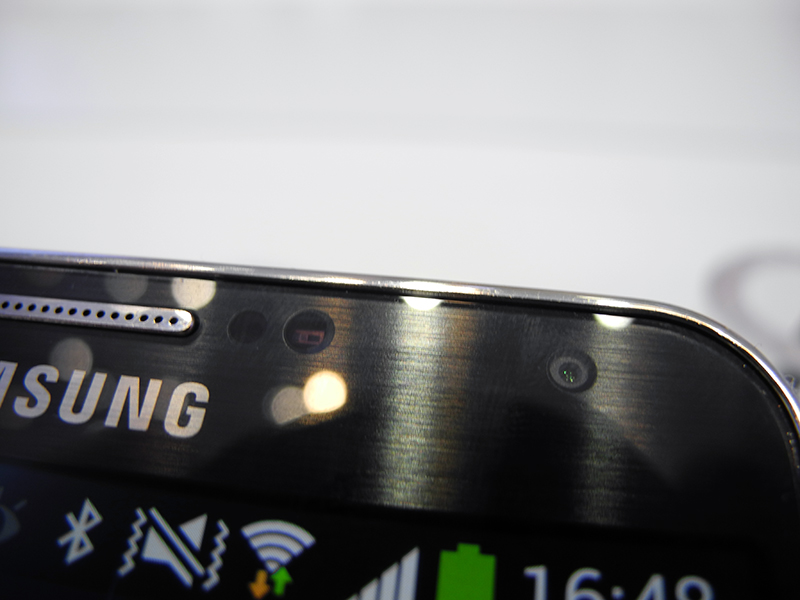

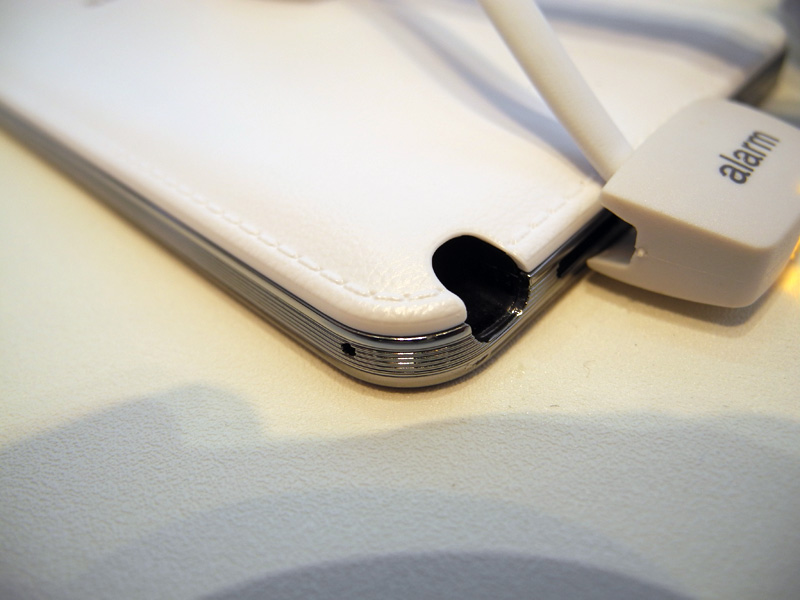
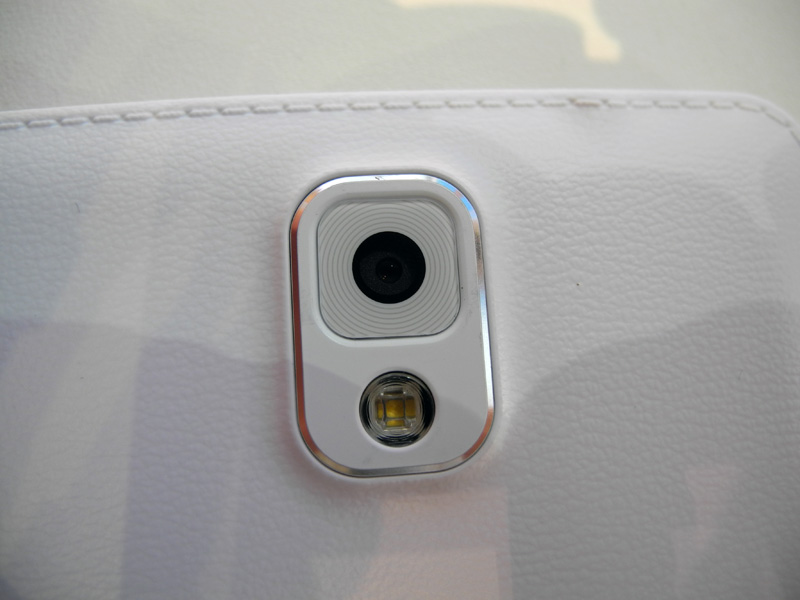
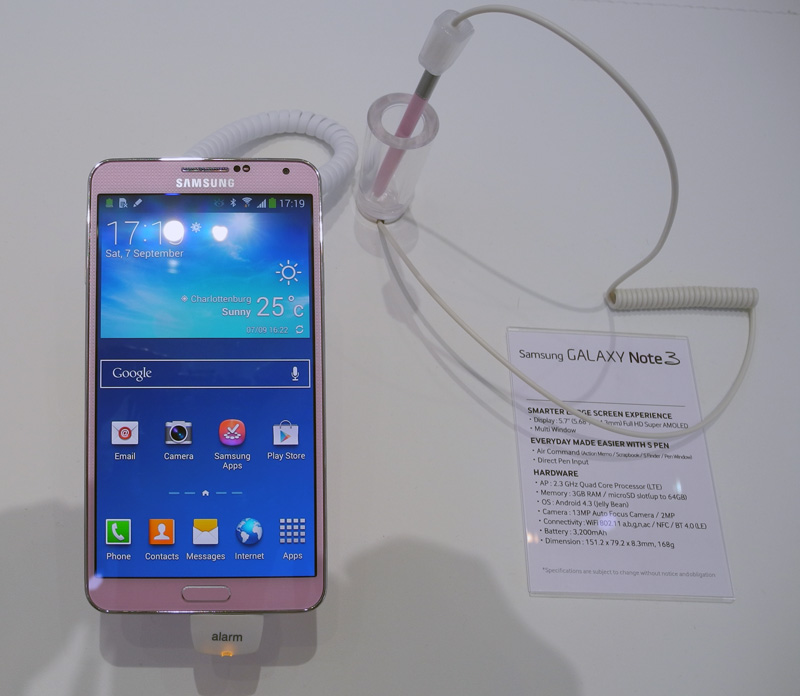


Earlier, I had to deal with Samsung smartphones, but the Galaxy Note 3, in my opinion, is the first, the metal design elements of which really look like metal ones, you can’t confuse them with “silvered plastic” even in appearance. They are made very carefully, especially liked the metal mesh of the speaker on the bottom, slightly protruding metal plate covering the auditory speaker, and the one-piece swing volume control. Finally, Samsung does not look cheap!
Partly "expensive" view is achieved through the back cover, which is really made of leather. Extremely interesting decision, but is it practical? The fact is that going up to the white tablet Galaxy Note 10.1, the back panel of which is also trimmed with leather, I was unpleasantly surprised by the black stains on it. Notice that the exhibition samples rested on leather (!) Stands and were securely fixed, i.e. just did not fall. It turns out that the skin so quickly got dirty just because of dirty hands? And what will happen if you throw a smartphone or tablet on the bottom of the bag or backpack? And if you constantly wear it there? Already at home or in a car, the device will obviously not be lying on a clean white leather counter, as it was at the exhibition ...

Naturally, you can gently handle the cover, and all the dirt will come down, but my opinion is this: in a mobile device, constantly carried with you, the skin gives way to plastic in practicality. How long it will last in the white and pink versions is a big question. In this case, it is better to buy a dark gray Galaxy Note 3, traces of dirt on dark skin will not be noticeable for a very, very long time.
Galaxy Note 3 has an LED event indicator. It is hidden under the front panel and is lit with diffused light. It turns out to be funny: at first you want to “put the focus on”, you squint, and only then you realize that “sharpness” is not initially provided for. Like, "fishechka" such.

Speaking of the Samsung Galaxy Note 3 can not be said about the covers, released specifically for him. I also liked them very much, and this is what: the back wall of the smartphone so tightly adheres to the wall of the case that it seems as if the smartphone and the case are one. For several seconds I tried to find the place where the cover and the smartphone were connected! And after all, the back wall of the cover is exactly like the lid of a smartphone, not to distinguish it! Developers for such a "close relationship" Galaxy Note 3 and a protective device - five points.


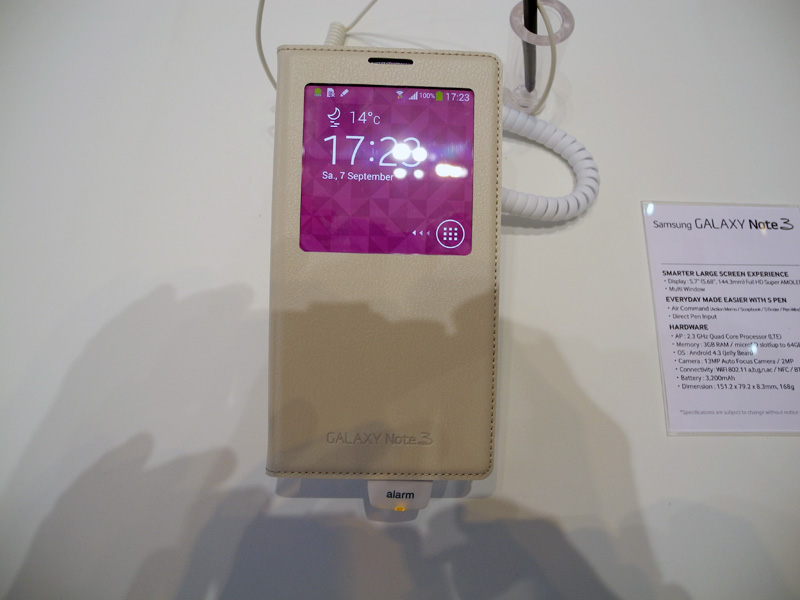
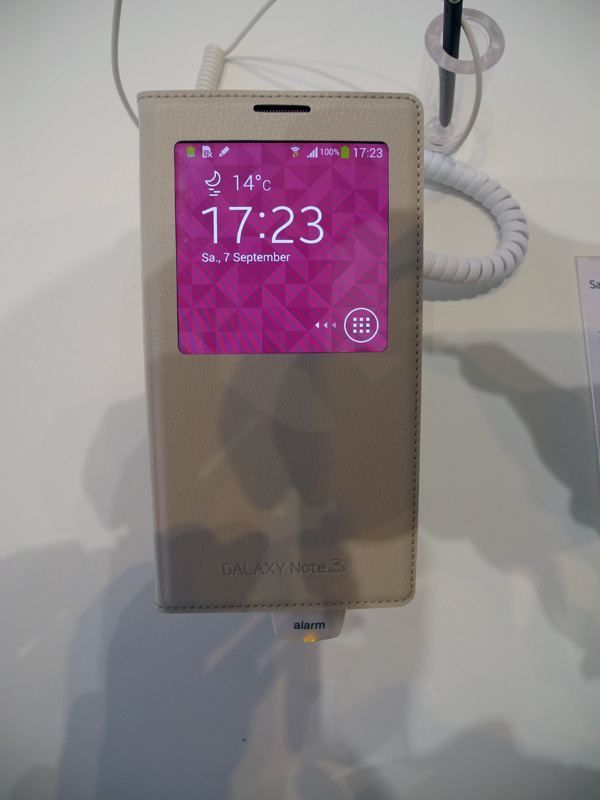
Samsung Galaxy Note 3. Software and settings.
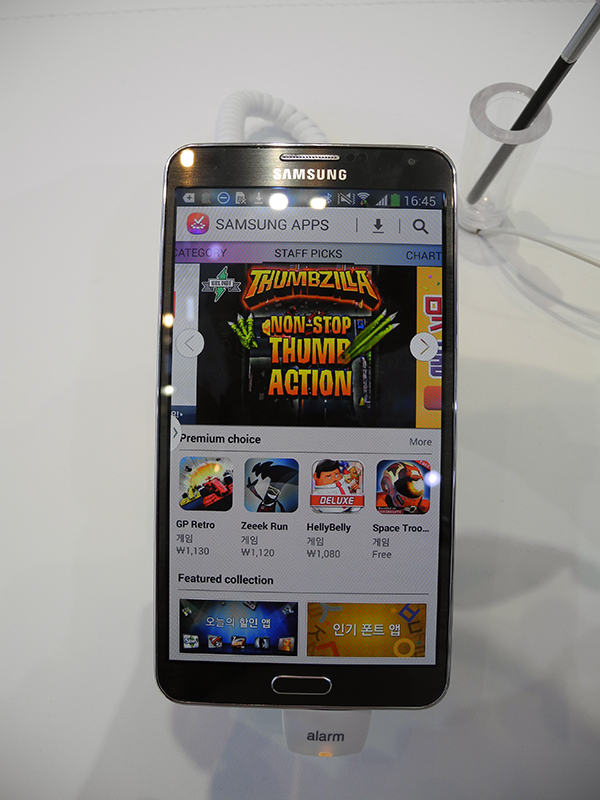
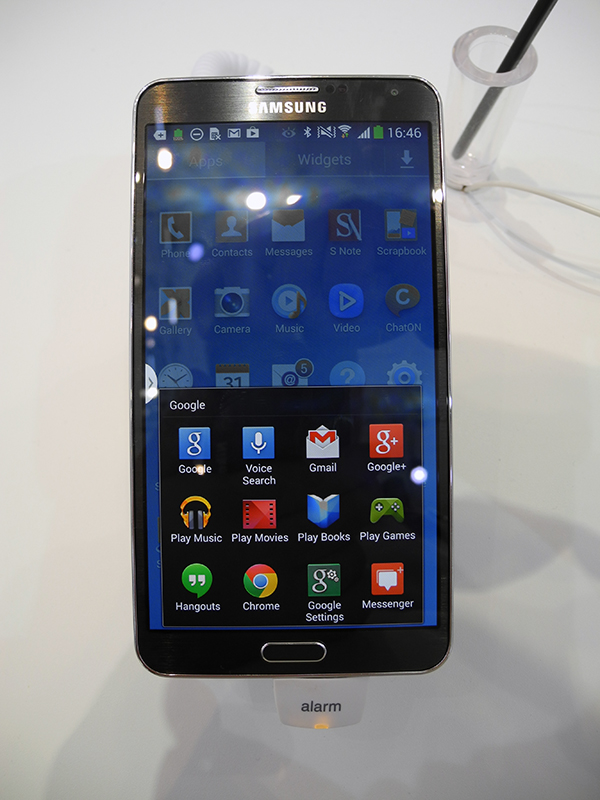
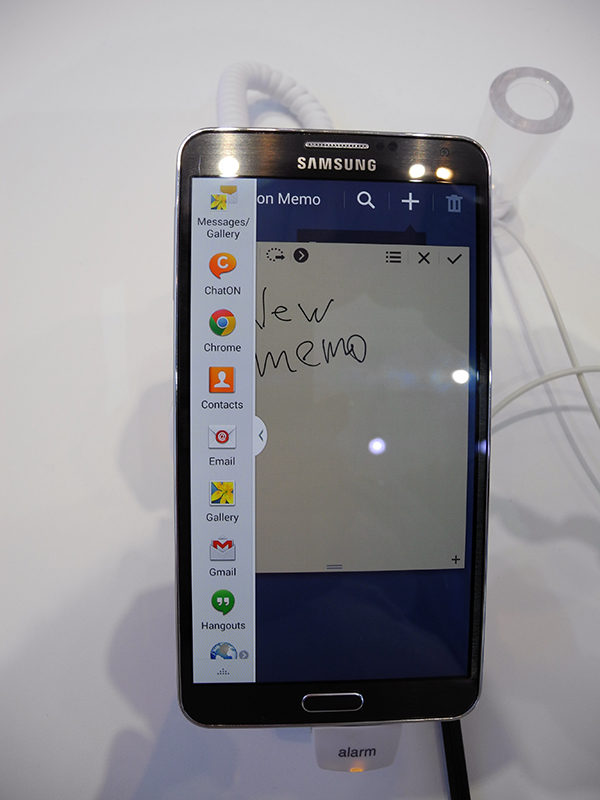
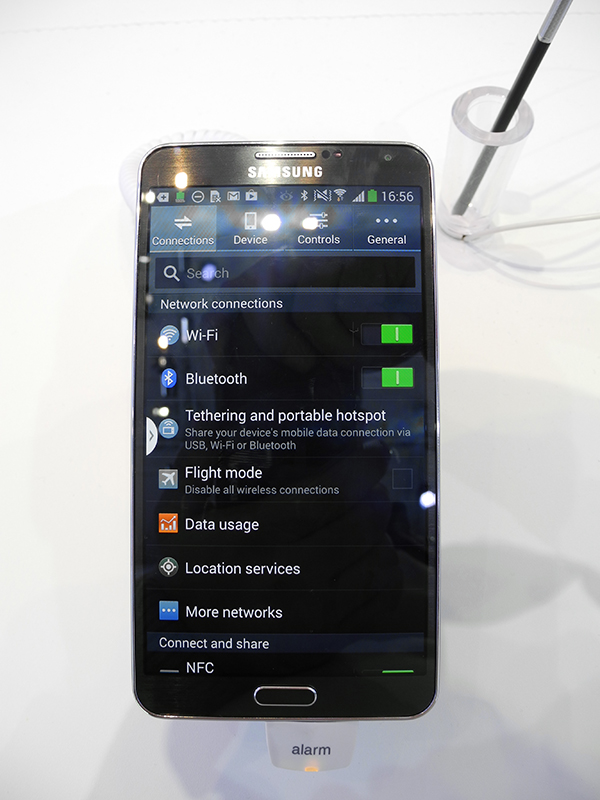

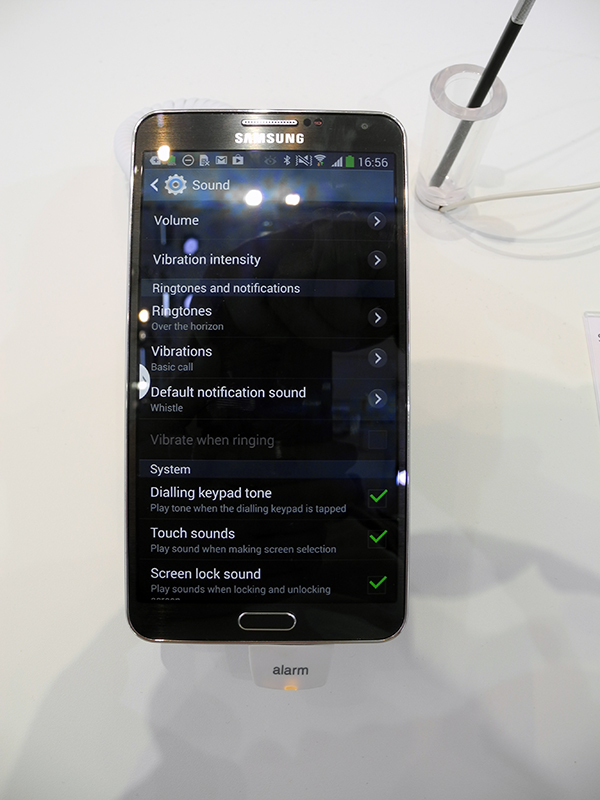
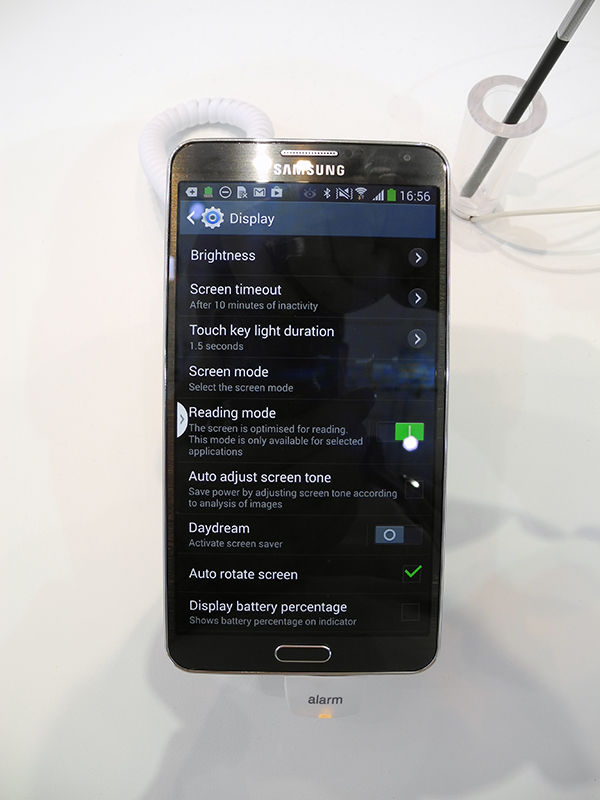


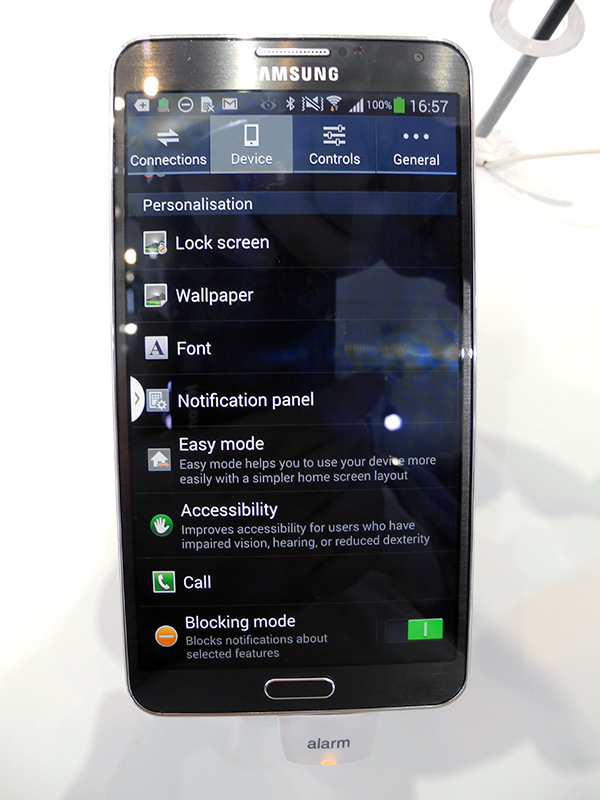
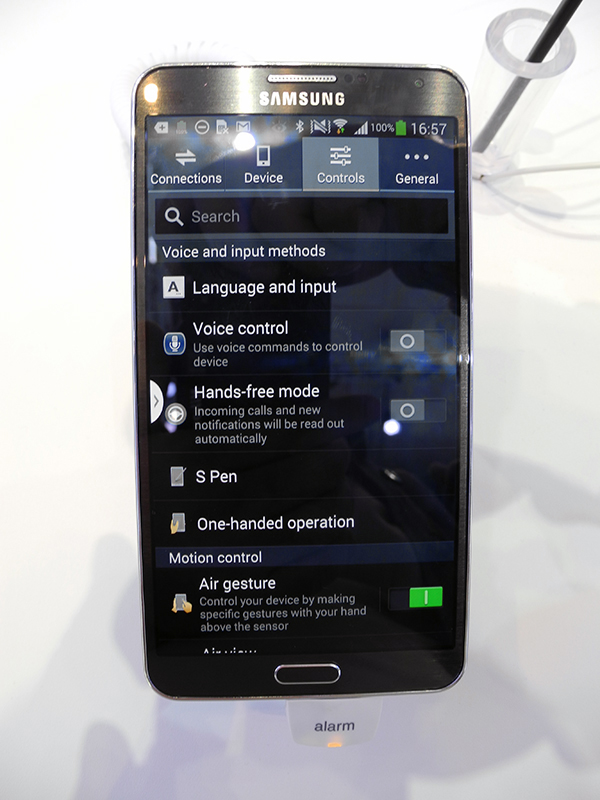





But let's move on from the appearance to the performance of the Samsung Galaxy Note 3. I managed to install on the version with LTE support (ie, on the Qualcomm Snapdragon 800 MSM8974 platform) and drive only two benchmarks: AnTuTu and NenaMark 2. The results are lower.
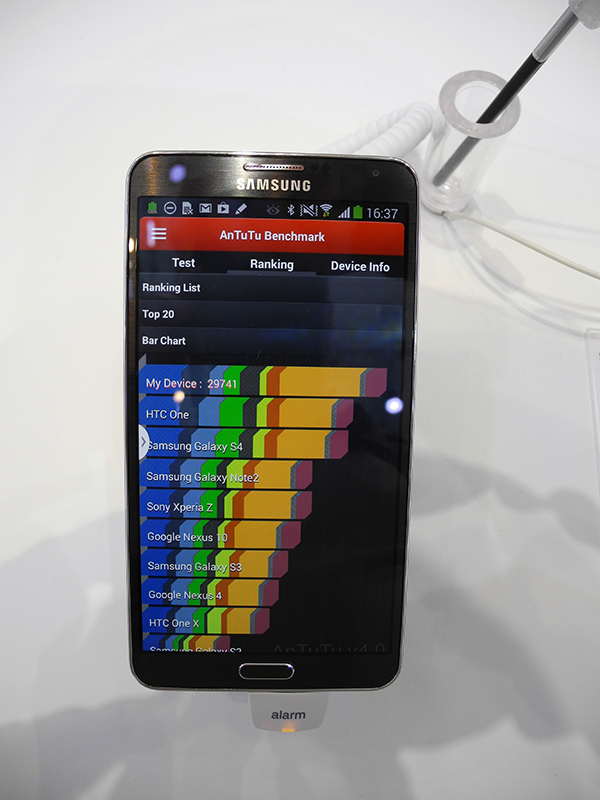
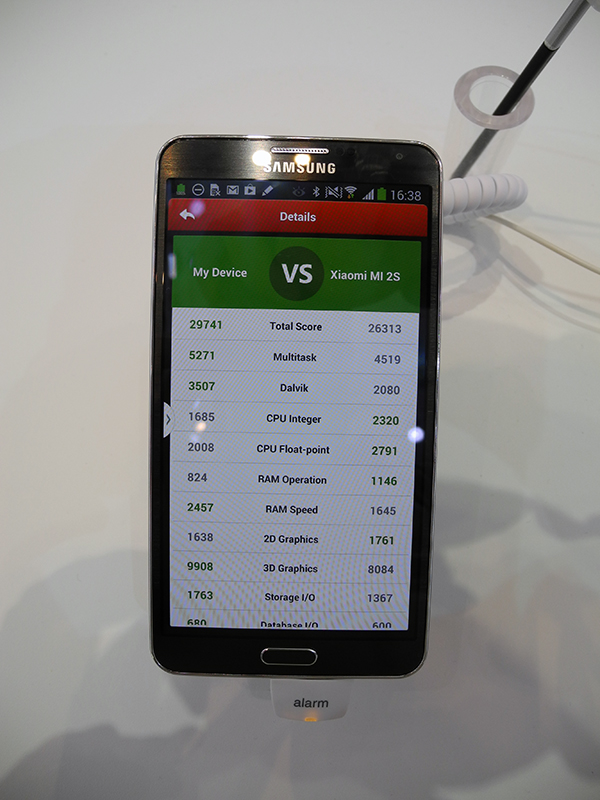

Obviously, the performance of the Galaxy Note 3 is high, and the Qualcomm Snapdragon 800 is strong. But how much? I tried to answer this question just below (see Toshiba section).
After the Galaxy Note 3, I immediately switched to the Galaxy Gear watch, which Samsung is very proud of.
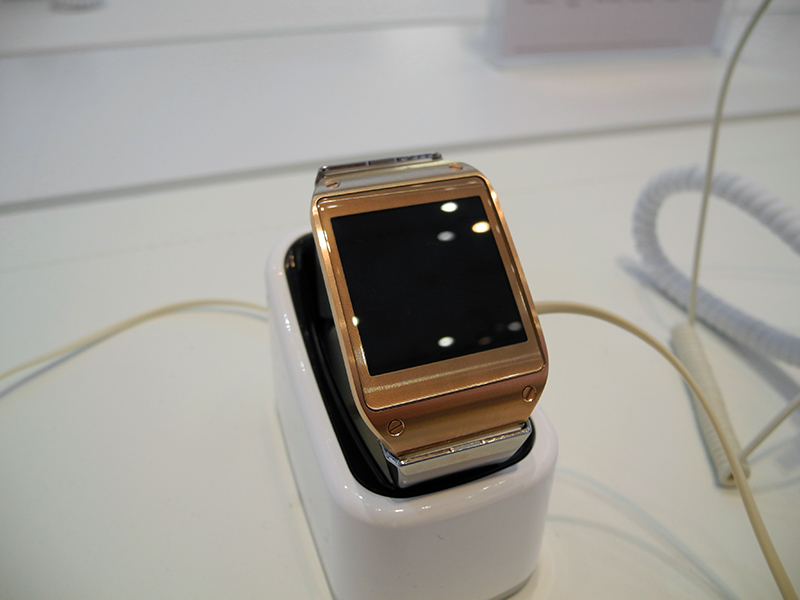
In my opinion, there is nothing to be proud of. The device turned out heavy and rather cumbersome. Several girls, who had been looking at the clock next to me for a long time, talked about the same thing - Samsung had got very big watches. And this is despite the fact that Galaxy Gear is focused more on the female audience than on the male. Here is such a feedback from the target audience ...

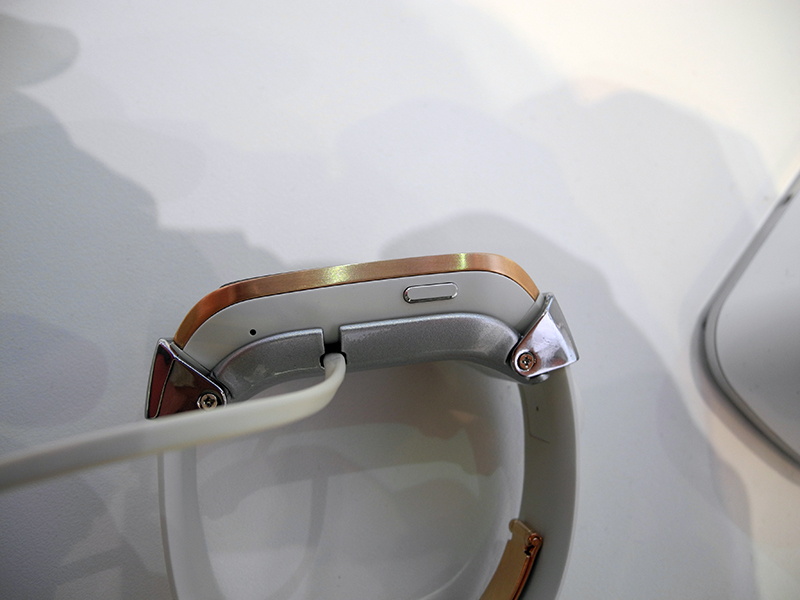

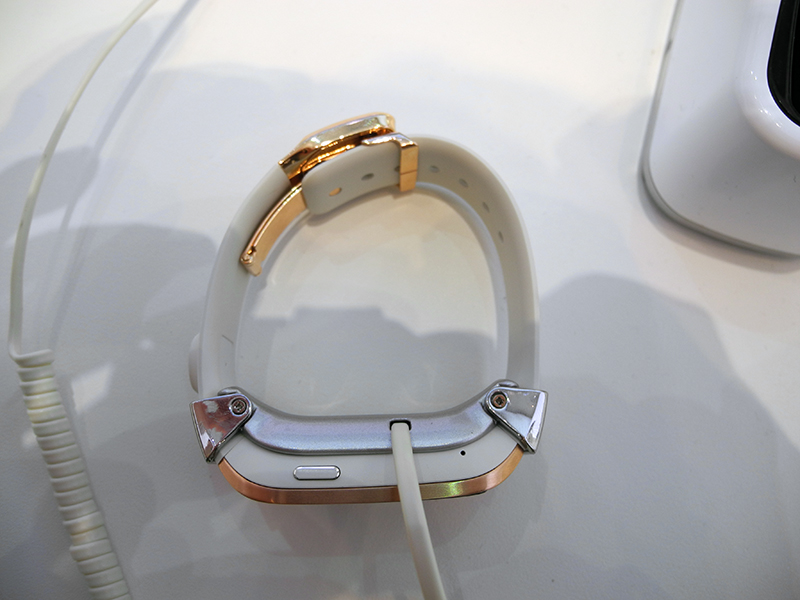
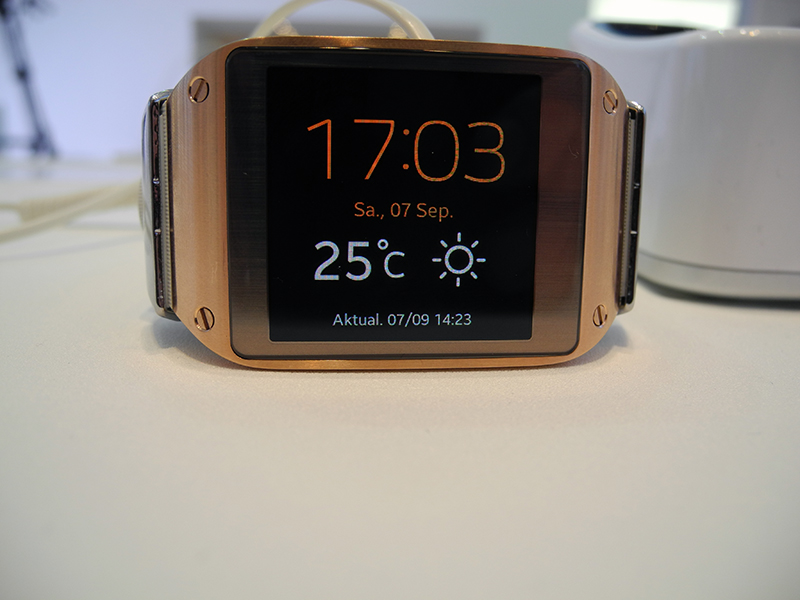
By the way, Galaxy Gear was hardly fastened on my hand. Another hint that they are not for the male hand?
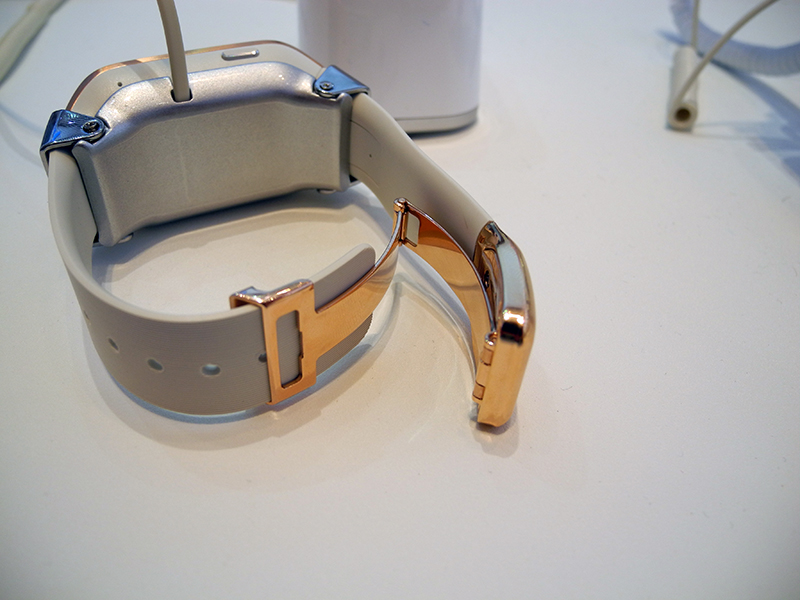

And it was also inconvenient for me to control the touch display. The screen is small, and if the fingers are large, then, for example, in the settings, when the screen displays three bars of sub-menu items, you should aim exactly at the middle of each sub-item, otherwise it is very likely to perform the very action that you planned. Maybe I just didn’t have time to get used to this particular watch, but, on the other hand, why would a person, “rolling away” half the cost of Galaxy Note 3 for Galaxy Gear, have to get used to something else? Why did I almost immediately figure out how to manage iPod nano, but I couldn’t master Galaxy Gear in 10-15 minutes? Certainly not because he did not want. In a word, I would advise Koreans to work on the interface yet. Template Android with its menus, in my opinion, is not suitable for such a device, the system must be seriously modified.
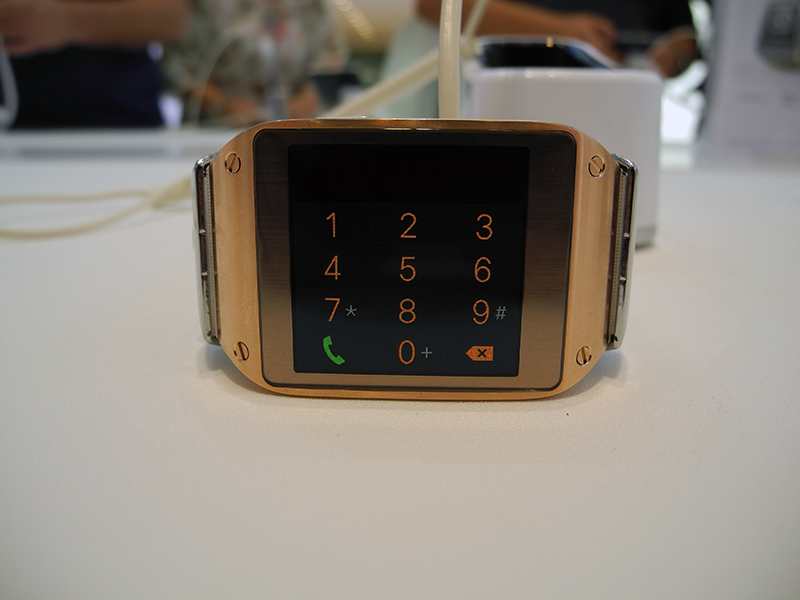
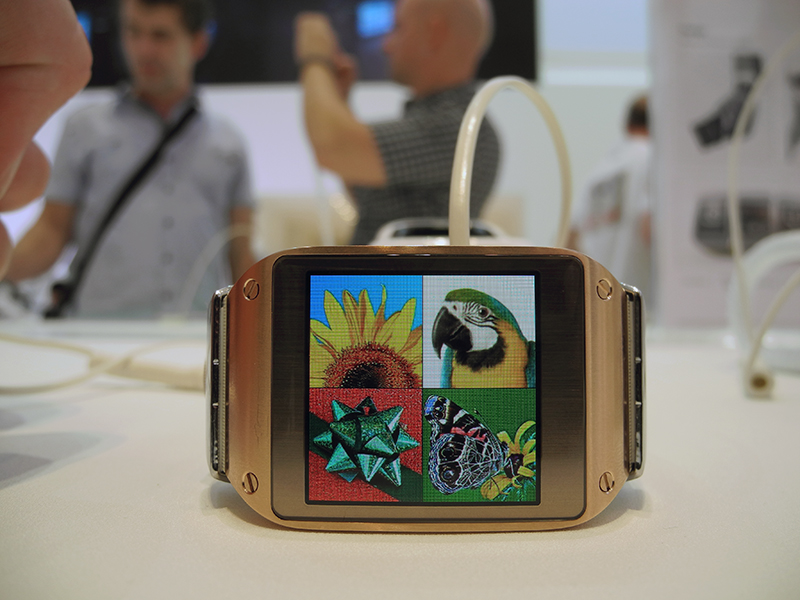
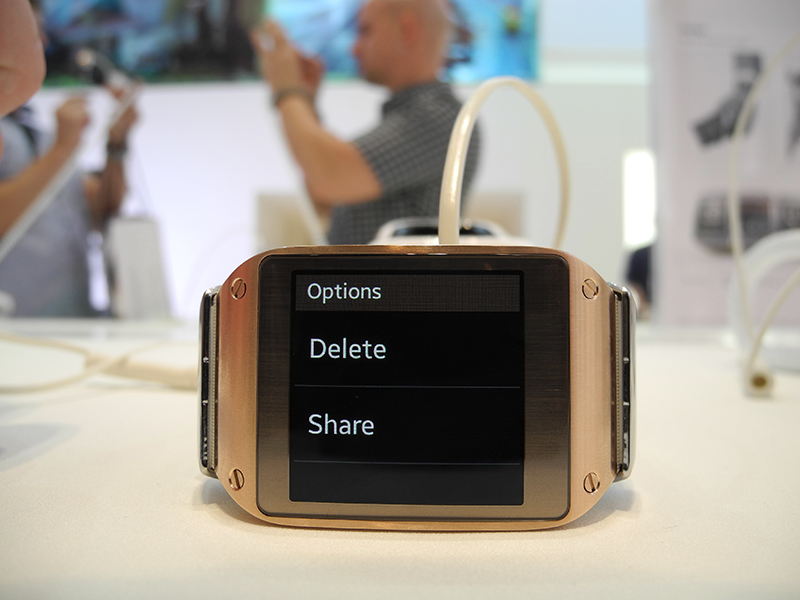

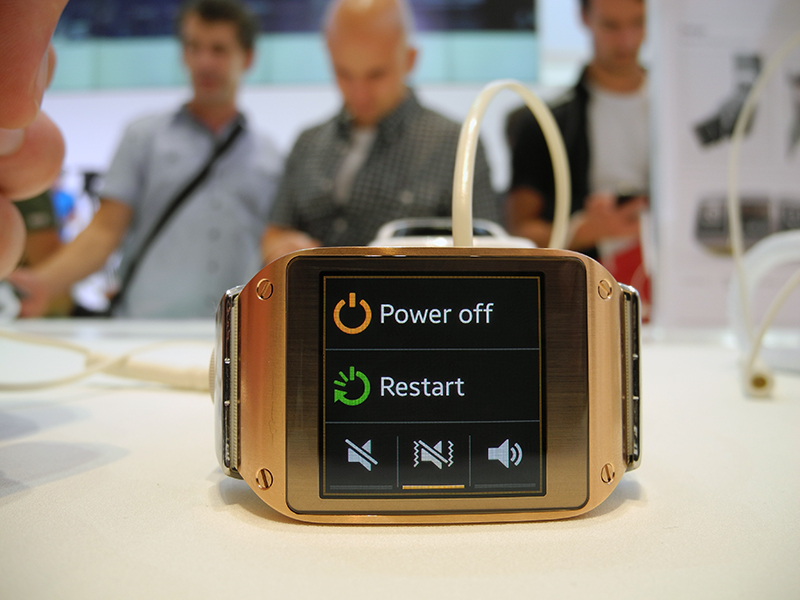
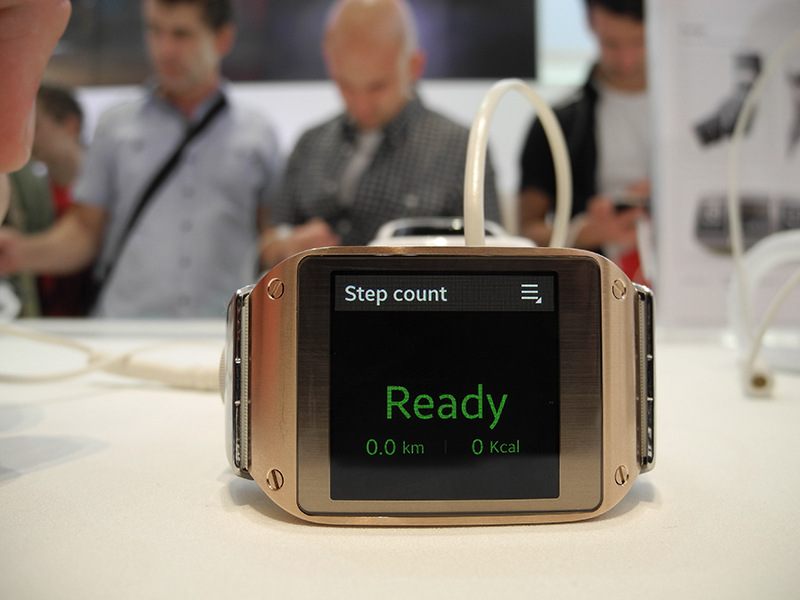

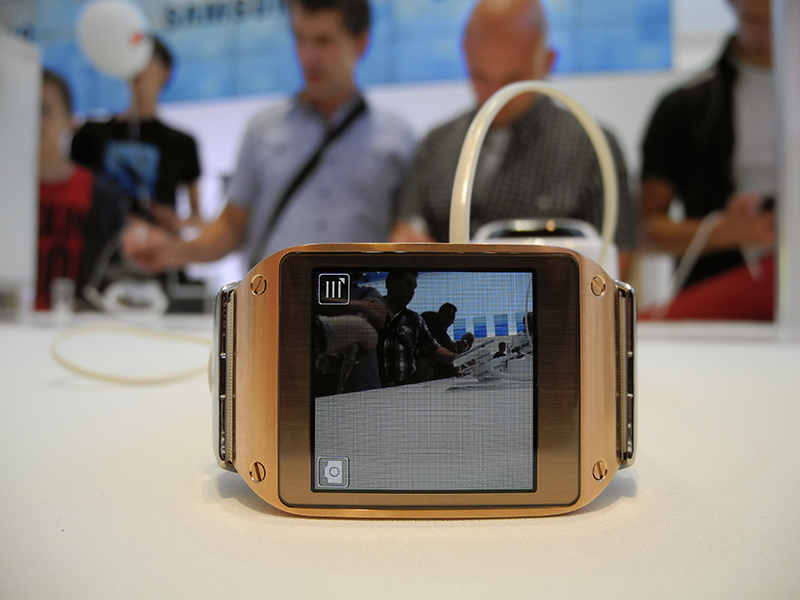
By the way, there is only one button in the watch, and this also does not make working with a wearable computer, which is Galaxy Gear, easier.
On one side of the watch in the peculiar tide area is a camera eye.
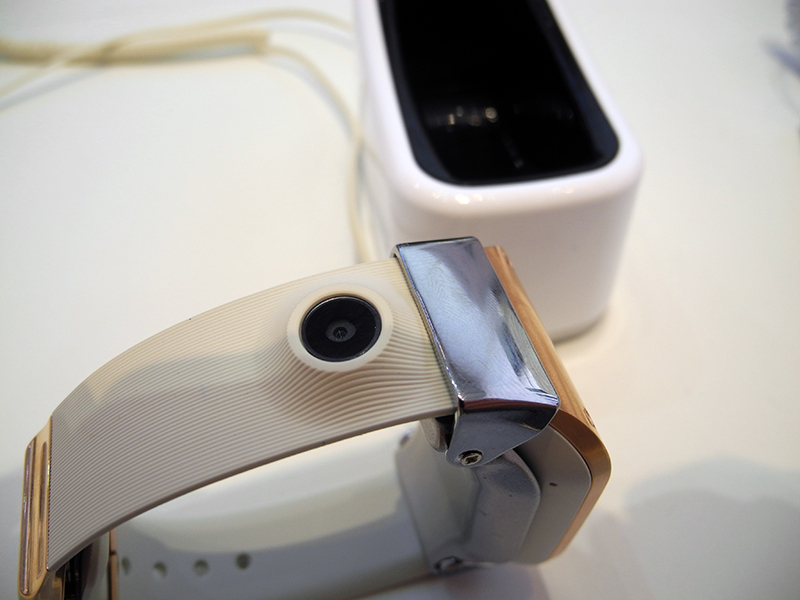
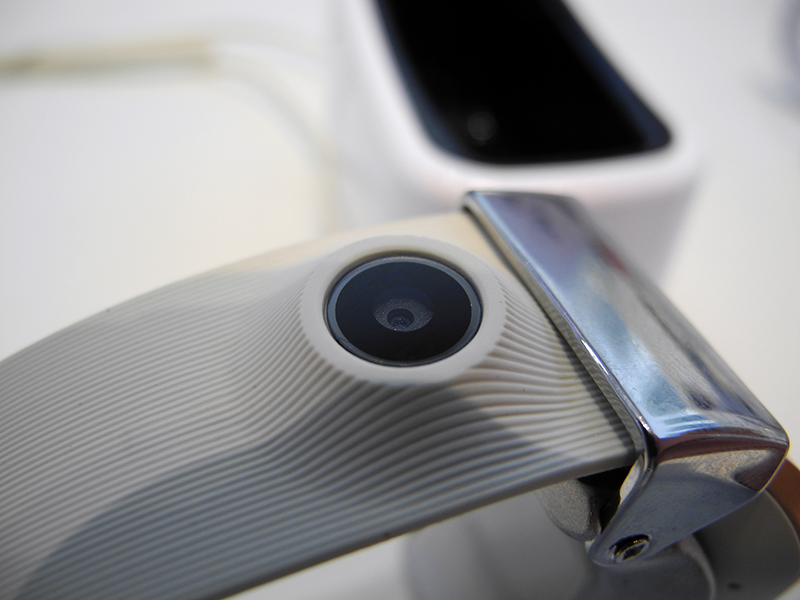
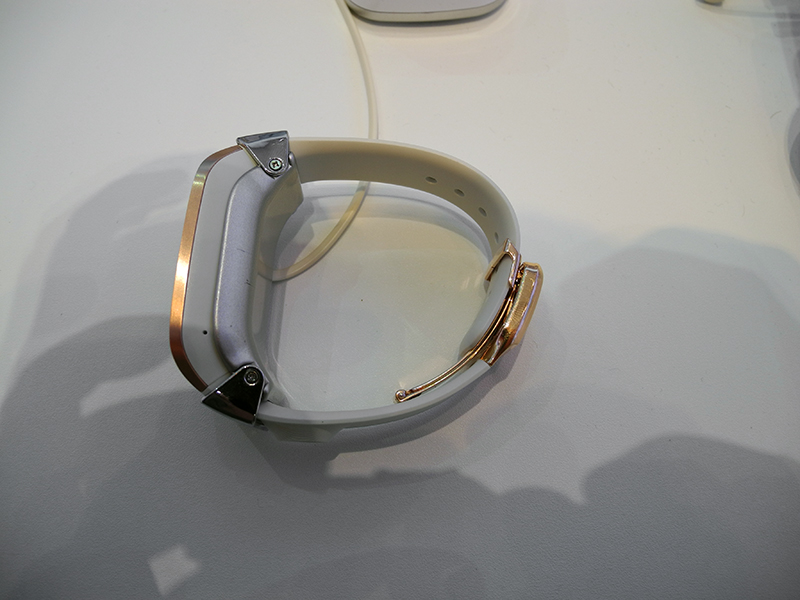
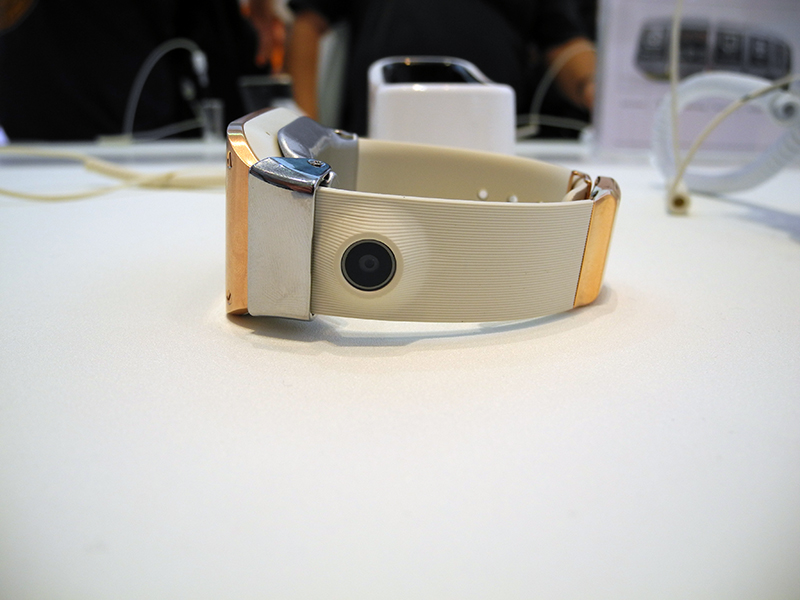
This arrangement makes it Galaxy Gear an excellent device for conducting "spy" shooting - see the video below: the girls standing nearby did not even notice that I was shooting them!
But for communication, it would be more logical to place the camera on the front panel, because anyone wearing a watch looks at the screen, not at the strap. Why did Samsung decide to make a garden with this strap, it is completely incomprehensible to me.
Finally, software. Watch the video below, it gives a complete picture of what the Galaxy Gear software component is.
I have to say that I didn’t like the Samsung watch at all, either by the performance or the look. I did not see anything in them that the Koreans could be proud of or at least brag about. Additional functions (such as a pedometer) are secondary, some of the main ones (here I mean, in the first place, the fish-eye of the camera) are implemented coarsely, the menu is completely intuitive. I remember well when in 2009 I saw the LG GD910 watch - then they made an effect on me. But now, after four (!) Years, Samsung, in fact, offers the same thing. And not just offers, presents it with great pomp! Like, we worked out, we worked, everything was for you. Casual mentioning at the same time that Galaxy Gear, firstly, is helpless without a smartphone, and secondly, so far compatible only with Galaxy Note 3 and Galaxy S 4. By God, it’s funny and sad. The same Sony does not make any hype out of its watches, which meanwhile have grown to the second generation, and I like this approach a lot more. Not to mention the Pebble.
In short, I tend to call the Galaxy Gear a big mistake of Samsung. Perhaps it is understood in the company, otherwise where did the rumors that this device will never go on sale, but instead a half-finished copy of the Galaxy Gear 2 will appear in six months?
This tablet is correctly called the stretched version of the Galaxy Note 3: the design, adjusted for size, is exactly the same.


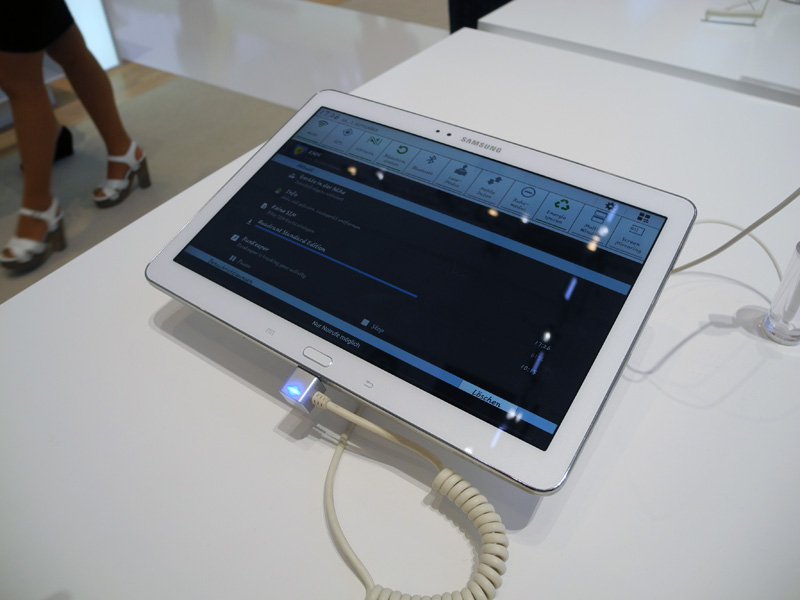
The new Galaxy Note 10.1 was presented in two colors: white and black. The second option I liked more due to the design of the front panel with sparkles, which "plays" in the light.
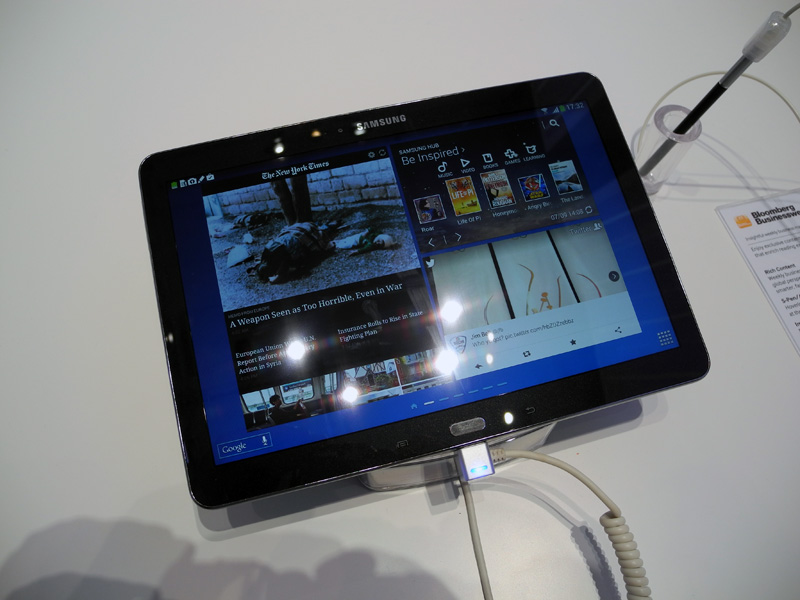

It makes no sense to describe the tablet in detail: everything that was said about Galaxy Note 3 applies to it.

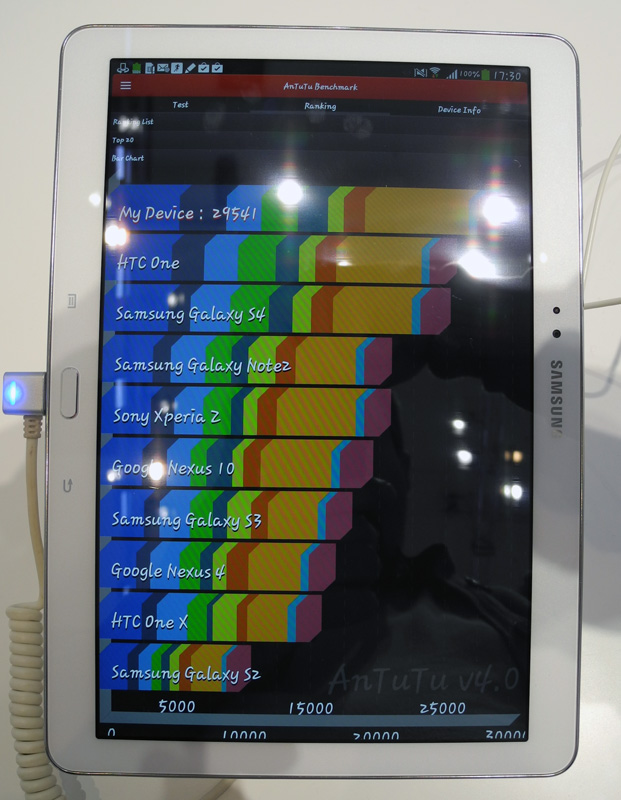
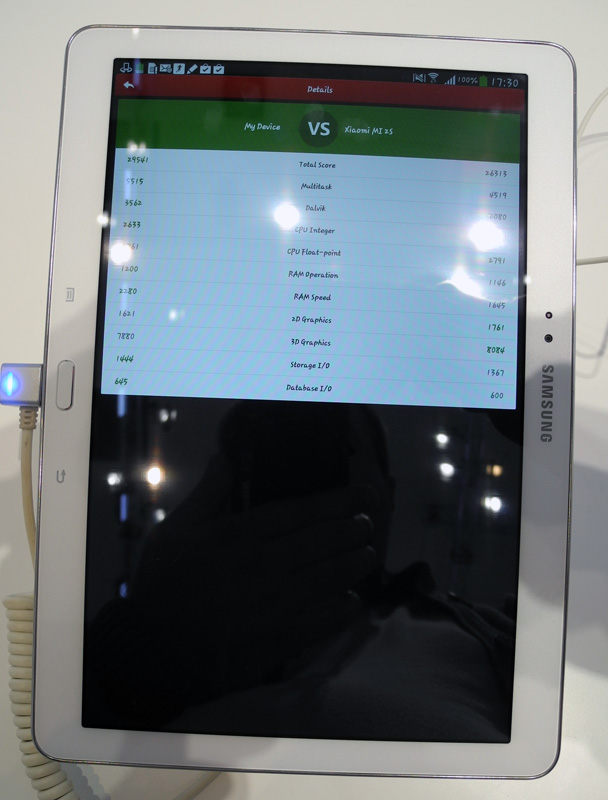
At IFA 2013, I discovered Toshiba tablets - I had never come across them before. I must admit, I liked the entire line of tablets of the Japanese company, but it is difficult to explain why. They do not represent anything outstanding in terms of design, software is also of the same type, as an example you can put only a clear division into niches and price groups (the flagship model is Excite Pro, the budget one is Excite Pure, some intermediate variant is Excite Write providing pen input) and modern characteristics (in Excite Pro and Retina display, and HDMI output is).
The greatest interest, of course, was Excite Pro, built on the NVIDIA Tegra 4 platform. Its characteristics, as well as some layout features, can be seen in the photo below.
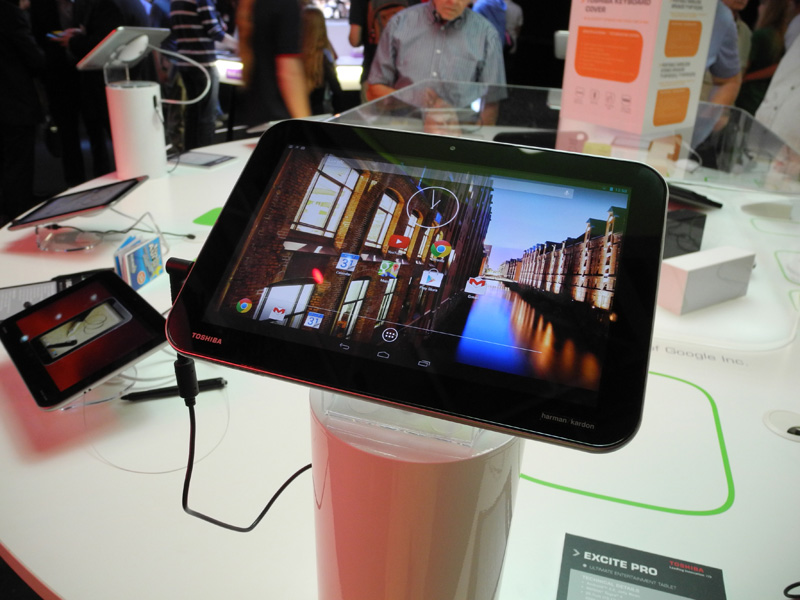
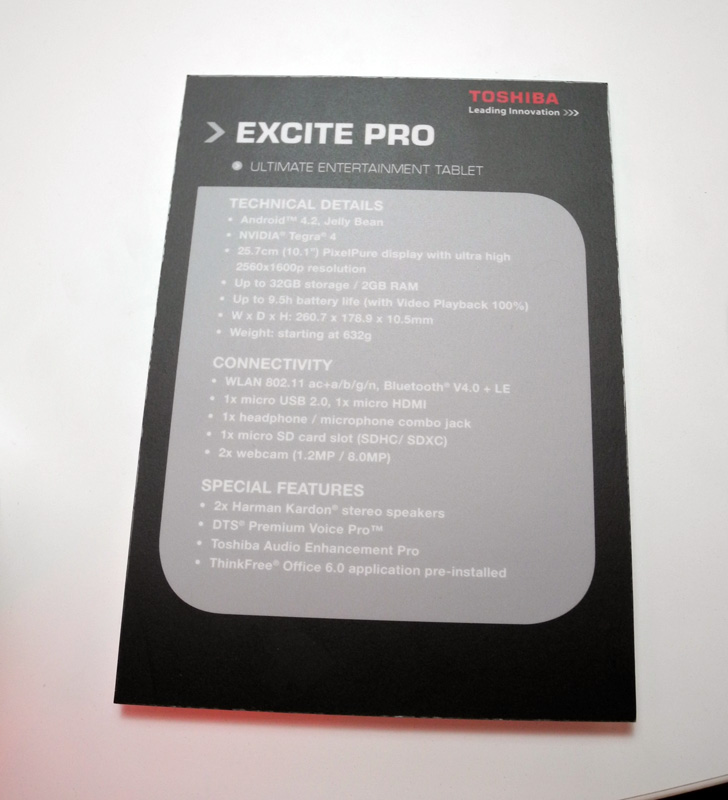


And now - about performance. I was able to run the device in three benchmarks: AnTuTu, Quadrant and Vellamo.
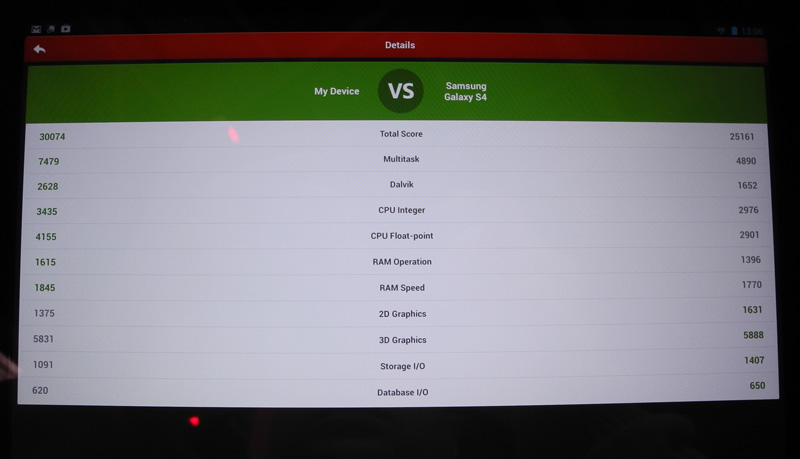
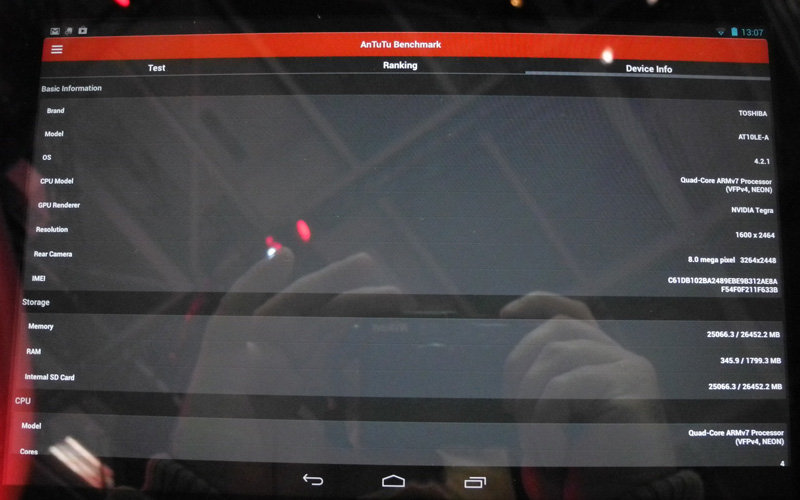

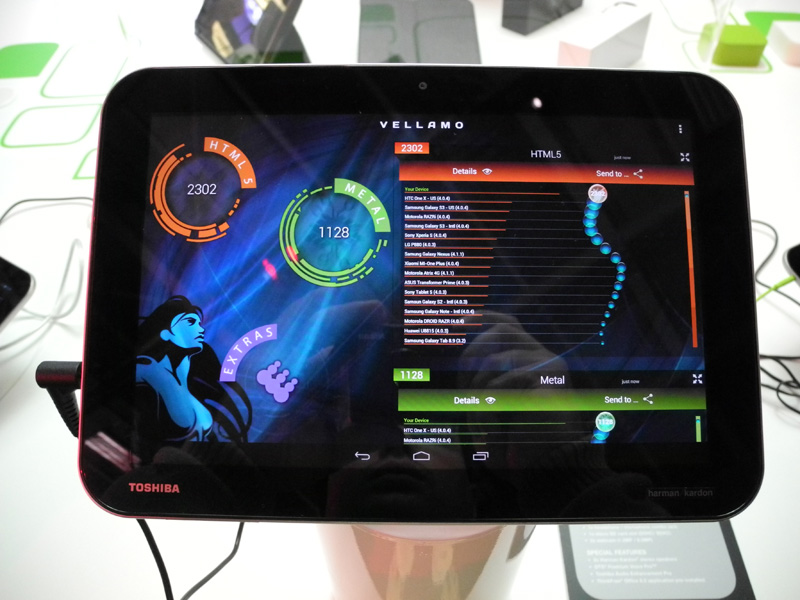
In the context of comparison with Qualcomm Snapdragon 800 in Galaxy Note 3, the most interesting result is Excite Pro in AnTuTu. Immediately I will note that in the tablet used so-called. Retina screen with a resolution of 2560 x 1600 pixels, and the Samsung smartphone uses “regular” Full HD, so the load on the Tegra 4 GPU was a priori higher. In order not to run my eyes on two photos, I summarized all the data in one tablet.
Tsiferki speak for themselves: in terms of CPU performance, NVIDIA Tegra 4 bypasses Qualcomm Snapdragon 800. With the GPU, the situation is not so straightforward, but it seems to me that if the tablet had a Full HD screen, then the graphics performance would be about the same level. Indirectly, this is confirmed by the fact that in the 2D graphics test NVIDIA Tegra 4 lost less than in the 3D test.
The only thing I didn’t like in Toshiba Excite Pro (and also not in many Chinese tablets) is the use of a separate charge instead of the usual microUSB cable.

In the satellites Excite Pro, the Japanese company offers a keyboard case.
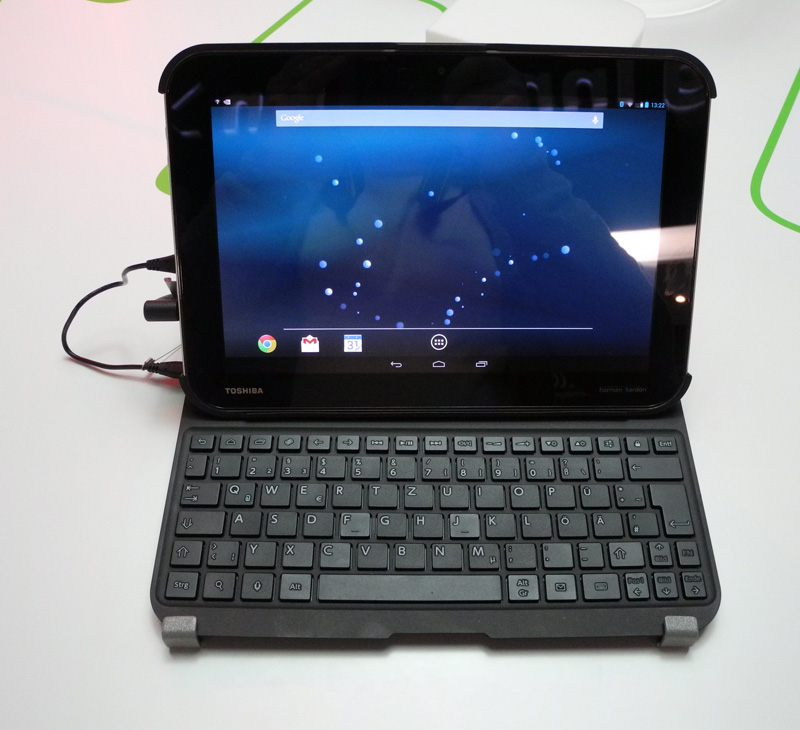
The highlight of the Panasonic booth was a 20-inch tablet with a 4K resolution, announced at the beginning of the year. The device is called - 4K Tablet.
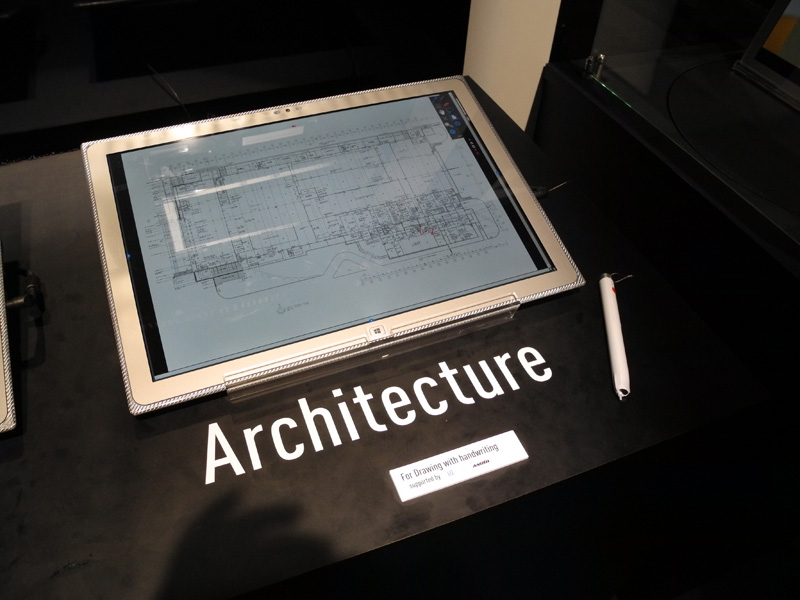
The device uses an IPS Alpha panel with a 15:10 aspect ratio and a resolution of 3840 x 2560 pixels. With a diagonal size of 20 inches, the pixel density does not seem at all impressive - only 230 ppi.
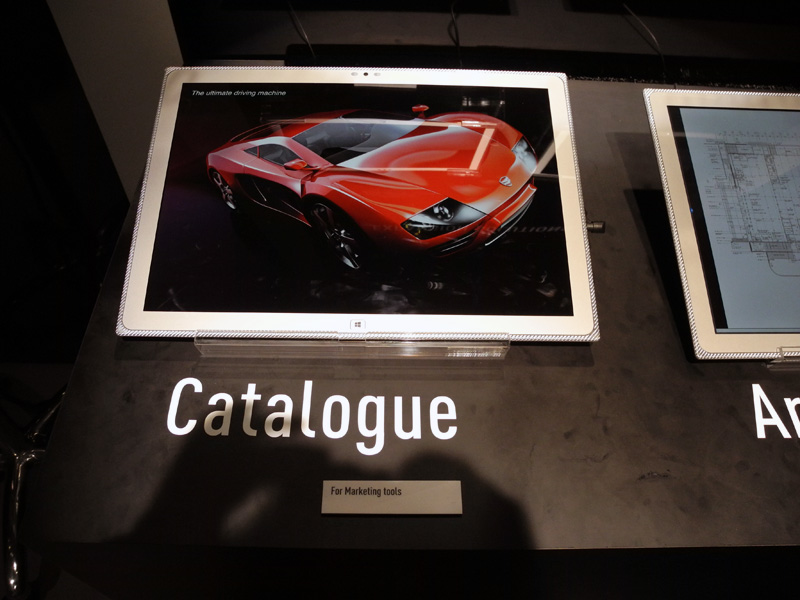
In the list of characteristics of the tablet - Intel Core i5-3437U 1.9 GHz processor, NVIDIA GeForce 745M graphics card, 4 or 8 GB DDR3 RAM, 128 or 256 GB SSD, Wi-Fi 802.11a / b / g / n adapters and Bluetooth 4.0, one USB 3.0 port, one SDXC slot. There is also a dock connector. For 4K Tablet surcharge, you can equip Anoto Pen with a digital pen and support for smart cards.
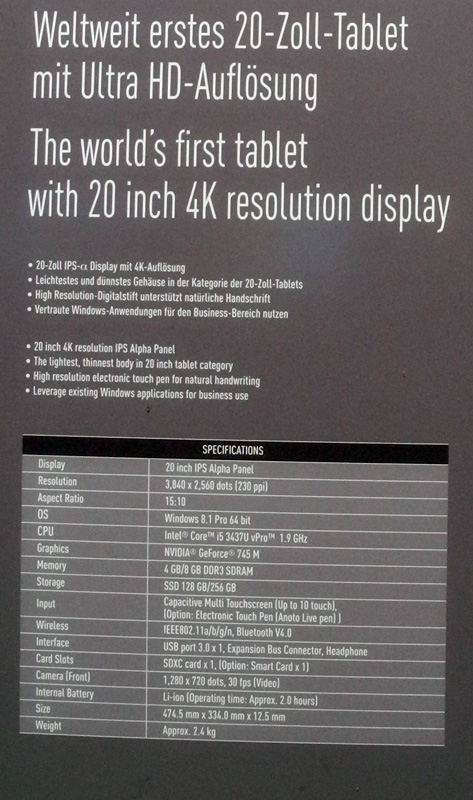
It was impossible to work with the tablet, access to the system was blocked. In fact, it remained to either consider beautiful pictures, or evaluate the work of the pen. However, I have something to note. First, the device screen is really good. But it is obvious, but more ...

4K Tablet is a kind of layout miracle. Judge for yourself: the case is thin, like a tablet, components - like a traditional laptop, the screen in general (so far) - is not of this world. As a result, there are lots of nuances. The device turned out to be quite heavy and not at all so portable as to carry it every day from home to work. Well, suppose it will lie on the table all the time, but then access to the connectors located on the sides is noticeably worse. And if the flash drive is still inserted, it may turn out (and then only if it is not thick), then it will be problematic to stick the memory card. I'm not even talking about the fact that in the “flat” position both ventilation openings and speaker slots will be blocked.

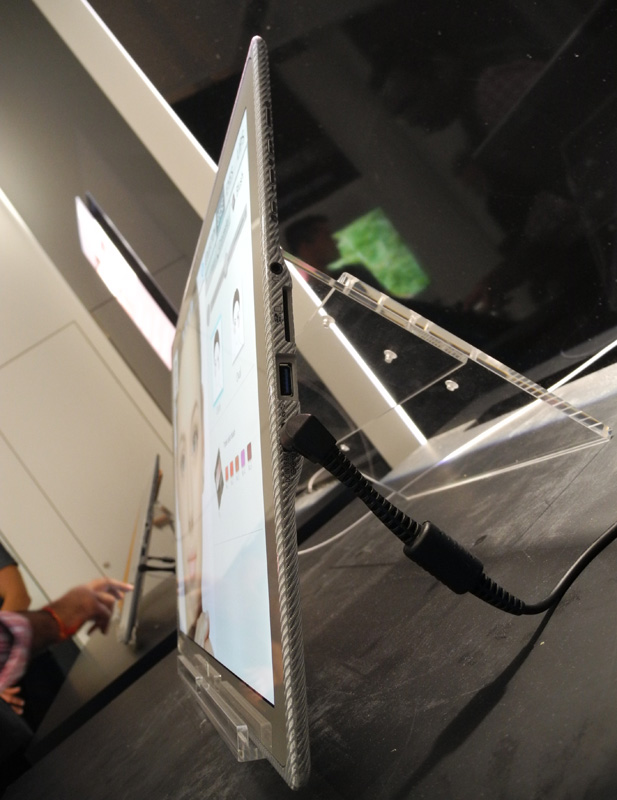

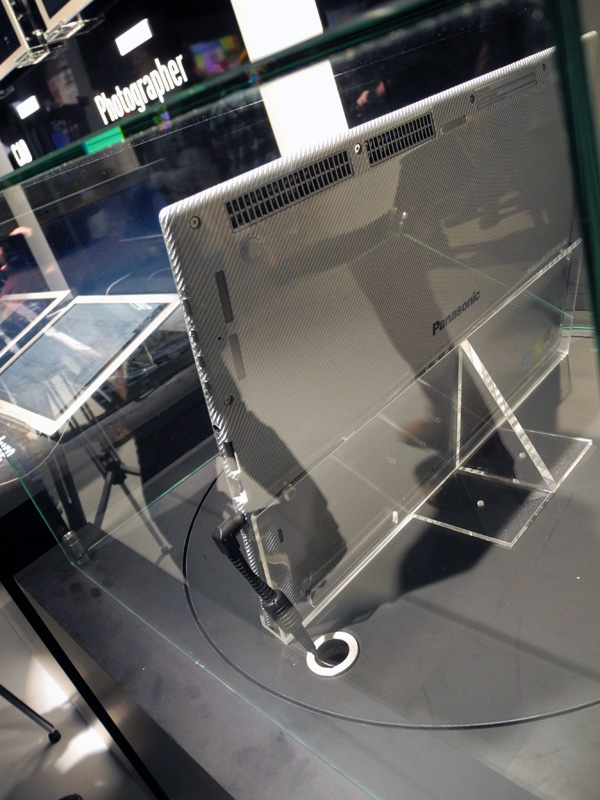
Another questionable, in my opinion, solution is the placement of LED indicators on the beveled part of the left side panel. Again, if the tablet rests on a horizontal surface, these LEDs will flicker ... on the table. And to judge the status of the drive, memory card, power circuit can be except for the gleam. Why not bring them to the front of the device is not clear.

And I also think that for such a large device, the claimed battery life - about 2 hours - is not enough. But this is already so, little things.
In general, while I do not see at 4K Tablet broad commercial prospects. At least in the current performance. Yes, it is possible that the device will be ordered by renowned design studios and architectural studios, but this demand will be satisfied. On the other hand, someone should be the first, and the first pancake ... Well, you know.
The Chinese company TCL "shot" on the IFA flagship smartphone Alcatel One Touch Hero.

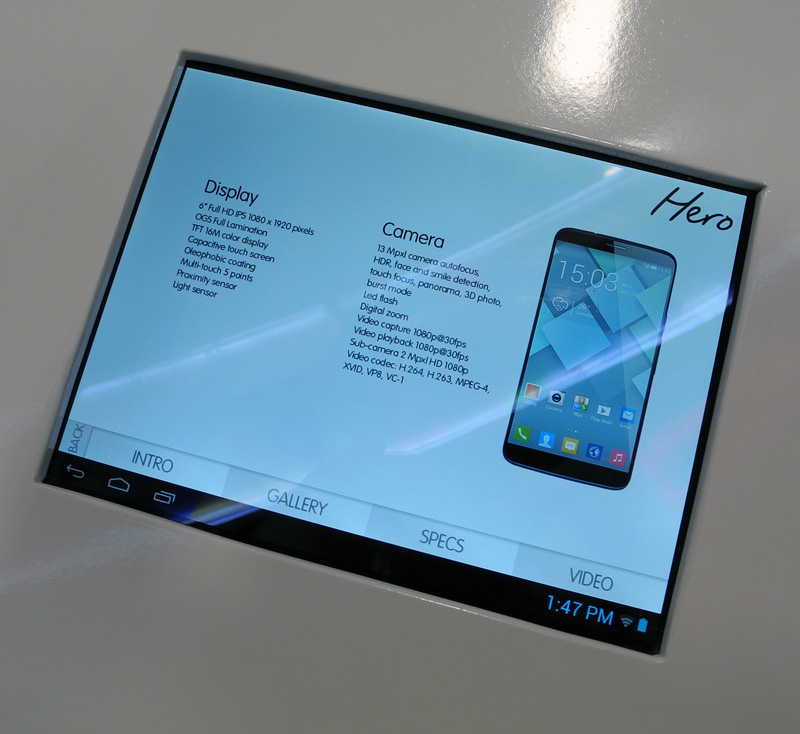
On the one hand, the characteristics of the device are really good - a 6-inch Full HD OGS screen with an olymphobic coating, a 13 megapixel camera, 2 GB of RAM, on the other - multitouch only 5 touches, the built-in flash memory reaches a maximum of 16 GB. In short, the flagship remains the flagship, but in its own, budget category.
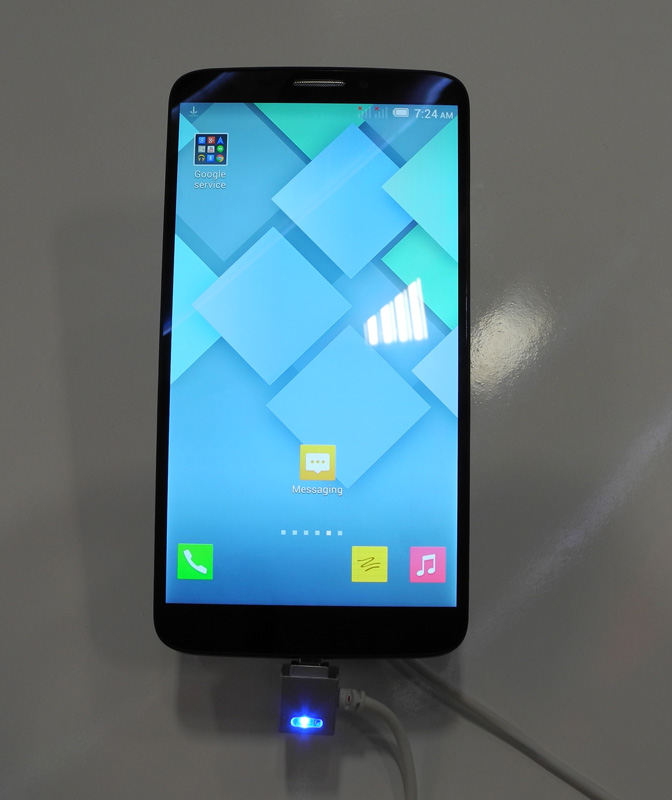
The assembly of the device is excellent, the panels fit tightly to each other. If the exhibition samples were so well made, it can be expected that the level of production of commodity devices will be at least as good. The device lies well in the hand, but its large size makes it impossible to operate with one hand. In fairness it should be noted that the developers have taken care of the ability to control certain functions of the device using gestures.
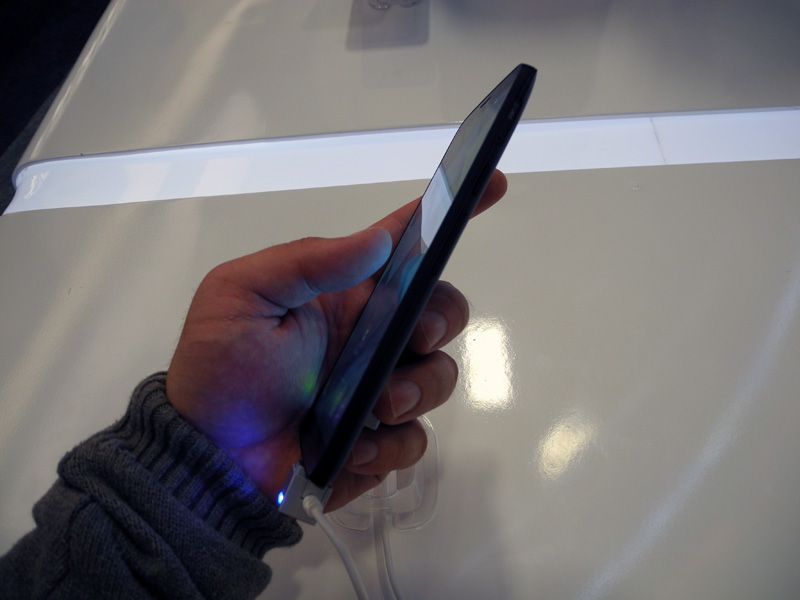
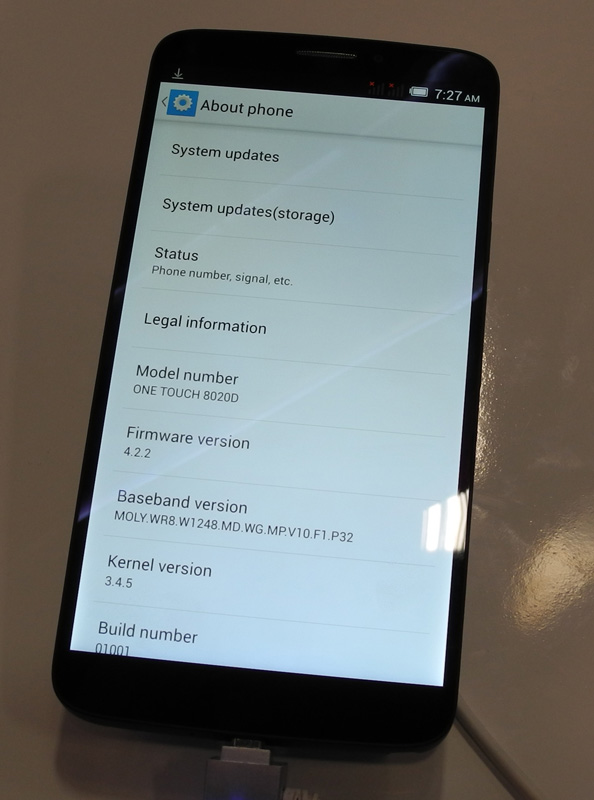
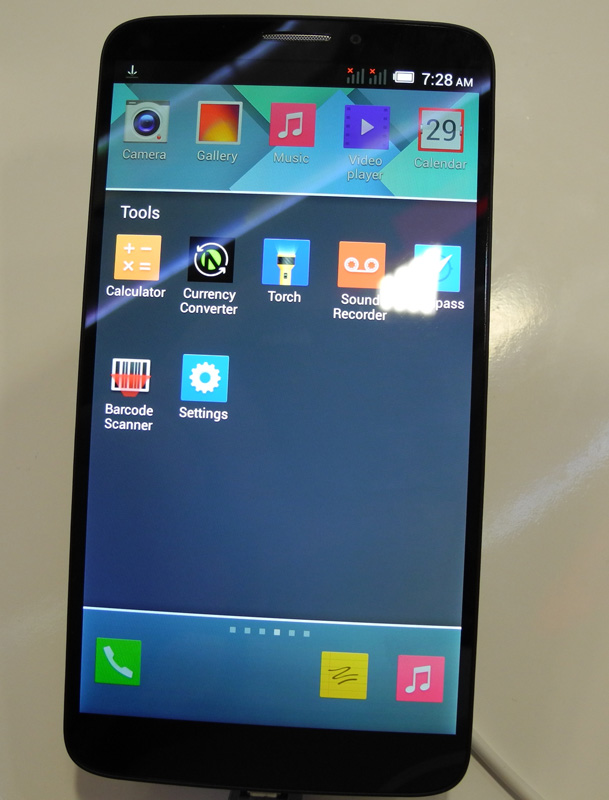
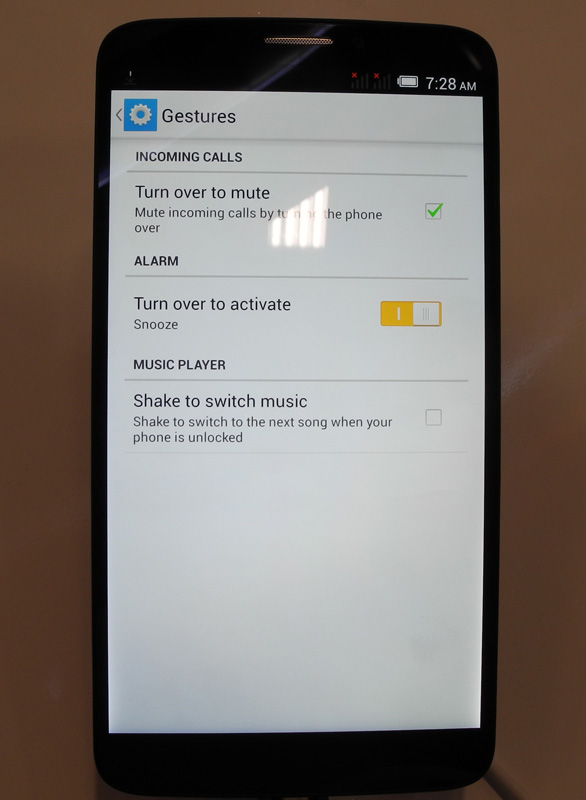


The back panel of the Alcatel One Touch Hero is made of high-quality matte soft touch plastic, on which virtually no fingerprints remain.
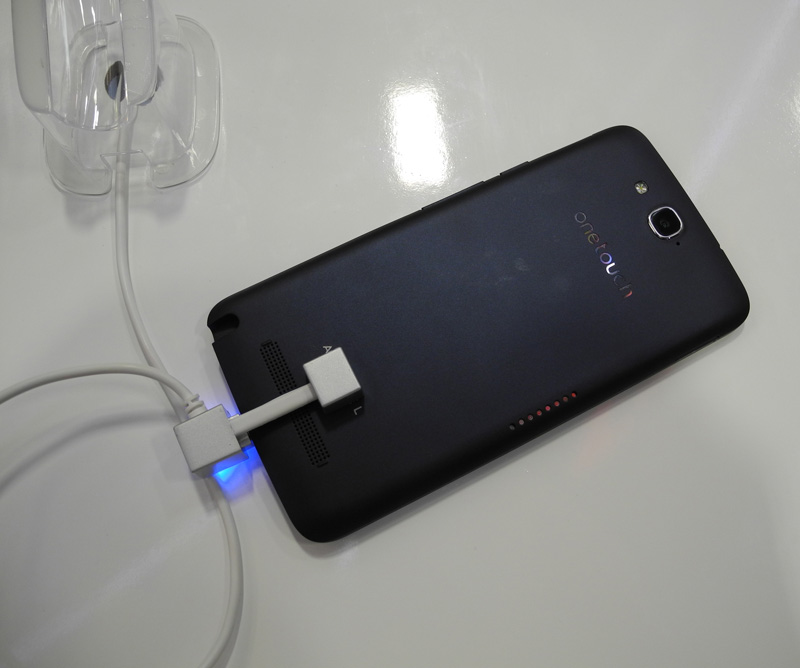
Unfortunately, the test of the smartphone did not work, at the TCL stand either it didn’t work, or the Internet was turned off. However, I have absolutely no doubt that this smartphone uses the MediaTek MT6589T platform, the capabilities of which are well known.
Next to Alcatel One Touch Hero, MagicFlip accessories designed specifically for the flagship model were exhibited: a cover with a built-in LED screen, a cover with an E Ink screen and a cover that provides wireless battery charging.


Another premiere of TCL at IFA is the Alcatel Pop C series of low-cost smartphones: C1, C3, C5 and C7. I would call this a kind of answer to the line of low-cost smartphones LG Optimus L, in which there are models L1, L3, L5, L7 and L9. Agree, it is unlikely that such a coincidence of names can be considered random. Especially after the idea of the release of the LG Optimus L proved to be effective high sales.
Actually, there is nothing special to talk about Pop C: multi-colored devices are a plus, but the case materials are extremely inexpensive, and the design is expressionless - these are minuses. Characteristics correspond to the budget class.

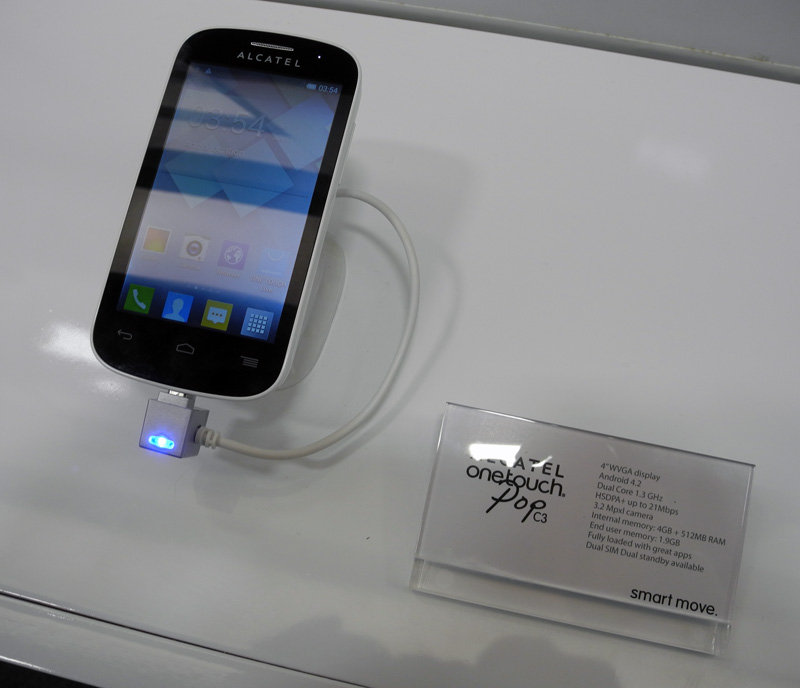
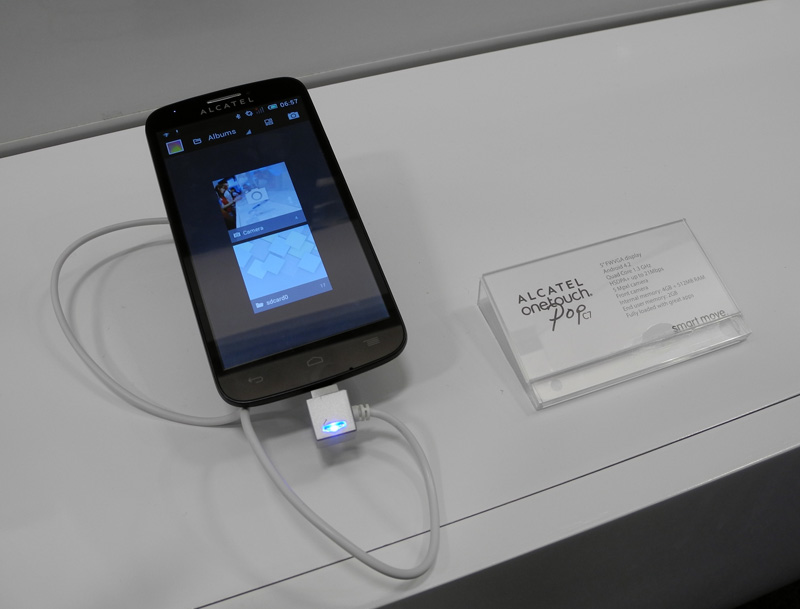
The only Alcatel tablet on display — the One Touch Evo 8 HD — didn’t like the look. First, the colors of the covers: they are somehow flashy and "stretched". Secondly, with materials: the soiled gloss of the front panel “excellent” is complemented by a brand and a slippery back panel. The screen brightness seemed to me insufficient.
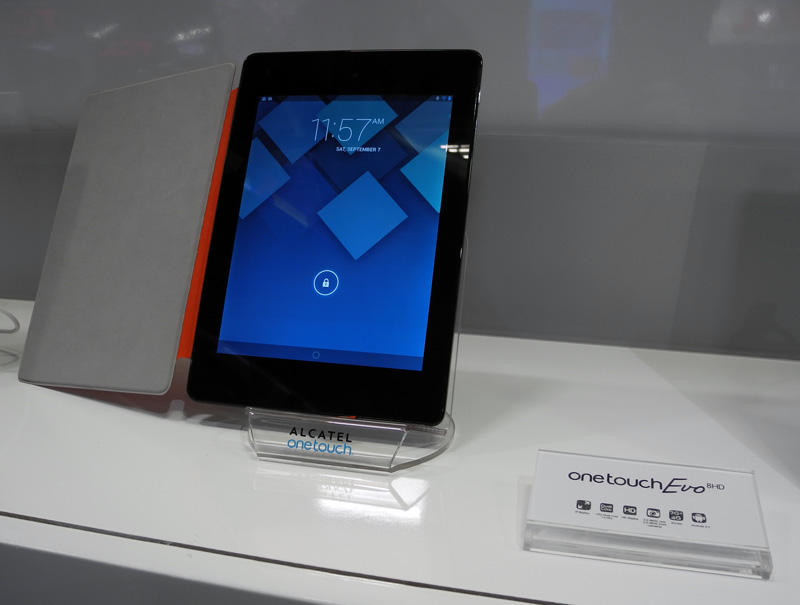
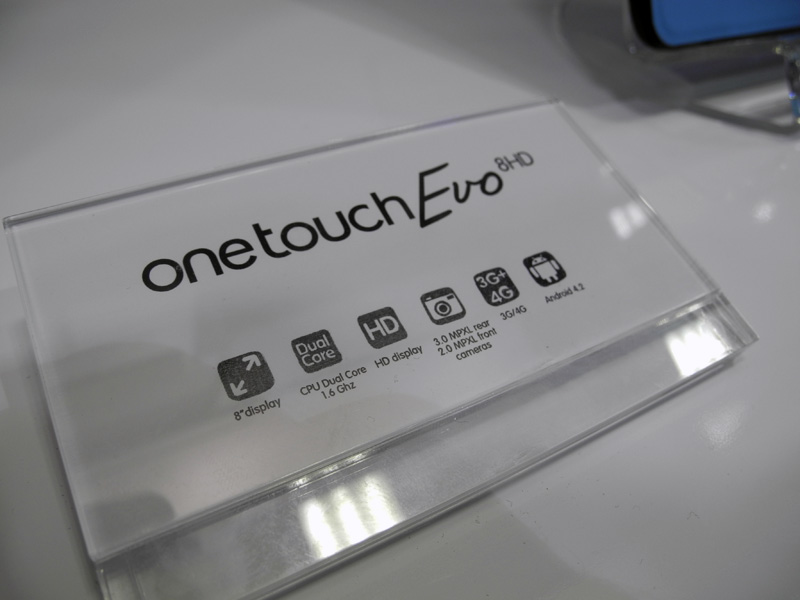
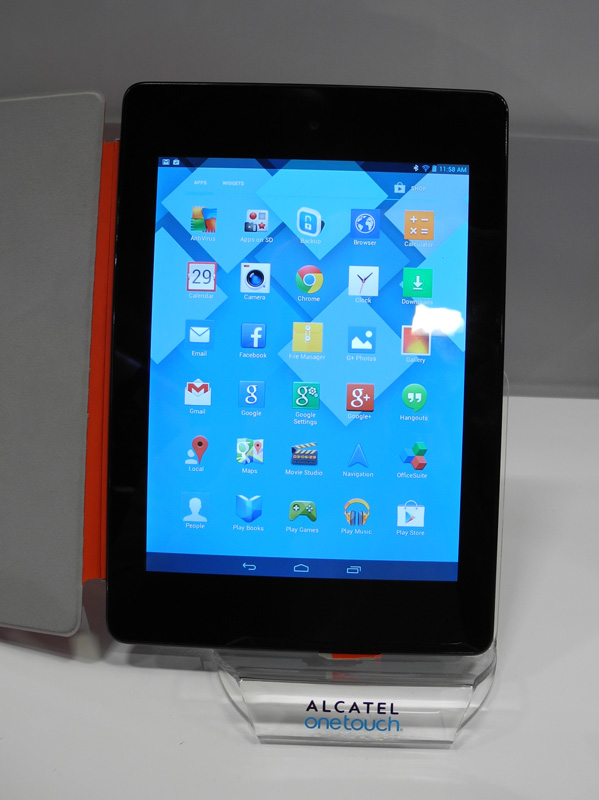
According to the software of the Alcatel One Touch Evo 8 HD - nothing interesting, the tablet is running Android 4.2. The technical characteristics are also nothing outstanding: a dual-core Rockchip RK3066 1.6 GHz processor, an IPS screen with a diagonal of 8 inches and a resolution of 1024 x 768 pixels, 1 GB of RAM, 4 GB of flash memory, cameras with a resolution of 2 and 3 megapixels. I am glad that the battery capacity is an impressive 4150 mAh. It should be assumed that the autonomy of this device is complete order.
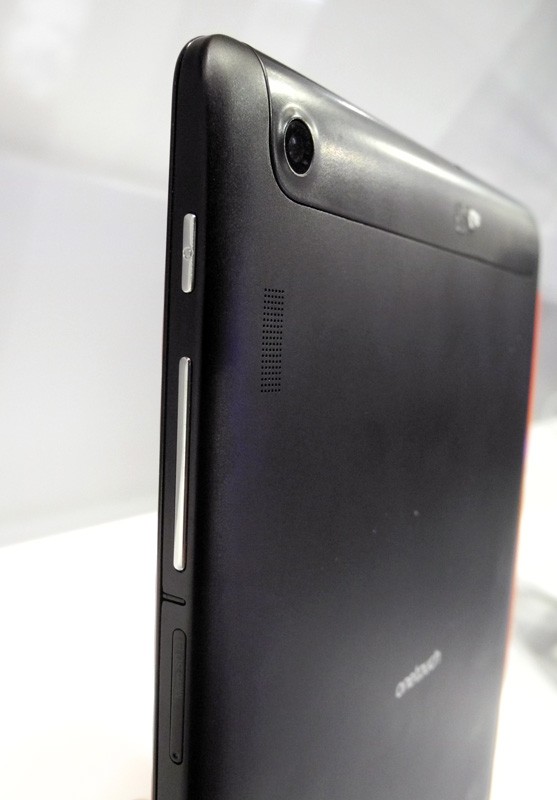

Once upon a time, when the tablets had not yet done everything, I was staring at the Archos products, then they seemed to me just cosmic. The time has passed, the industry has changed, Archos has begun to produce smartphones ... And now I would really like to turn back time, because the company showed at IFA how not to make smartphones.
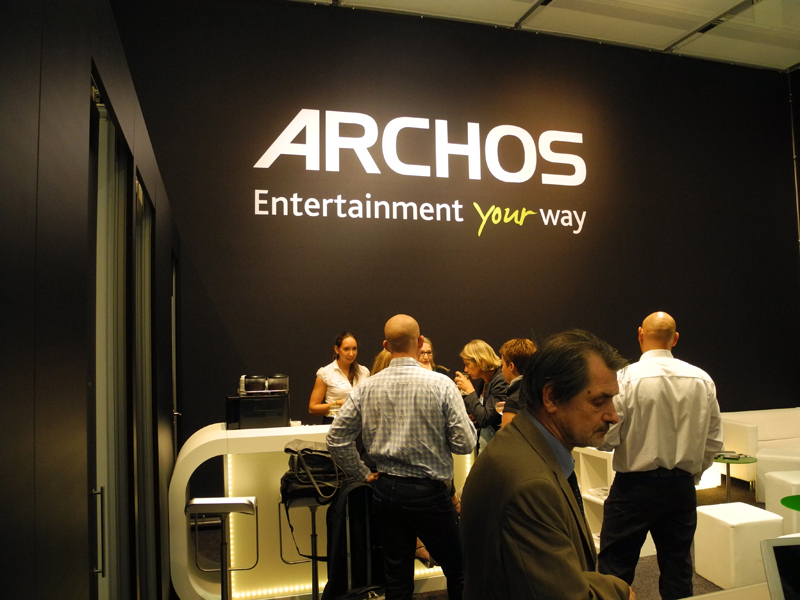
The line of "smart phones" Archos consists of three series - Titanium, Platinum and Oxygen, in which consumers are offered eight models. The first series includes low-end devices, the representatives of the second are characterized by “elegant design and top performance”, and the “oxygen” smartphones (as long as the line is represented by only one model), by definition, developers should be fast, productive and affordable.
I started to get acquainted with the devices of the Platinum series, and I finished them. Why? Because after the second device, Archos did not want to take the smartphones in hand. I got the feeling that the company, taking advantage of a fairly well-promoted brand in Europe, decided to ship the cheapest Chinese OEM to the Old World market. Obviously, they saved on everything: on equipment (see characteristics in the photo below), and on finishing materials. Last frankly upset Mark gloss is used in the design of the front panel and the back. And just make - it is mildly said! Fitting the hull halves is unimportant, there are elevators. Finally, the design of the Archos smartphones is simply absent.
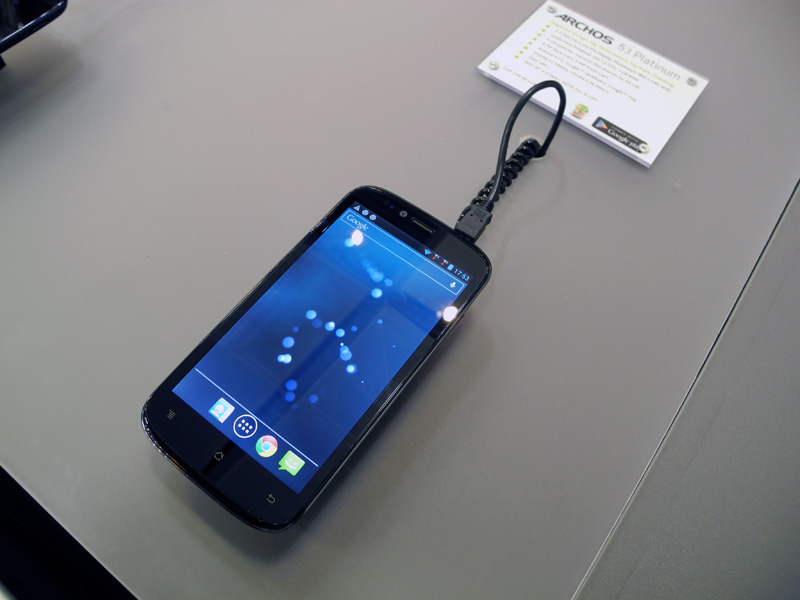
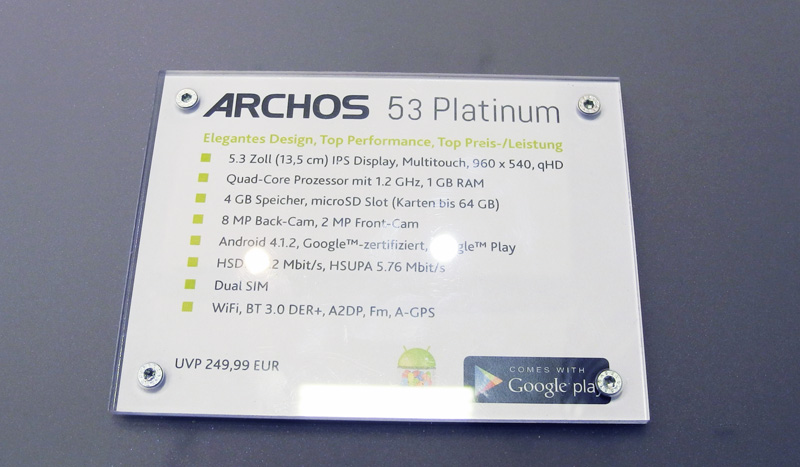
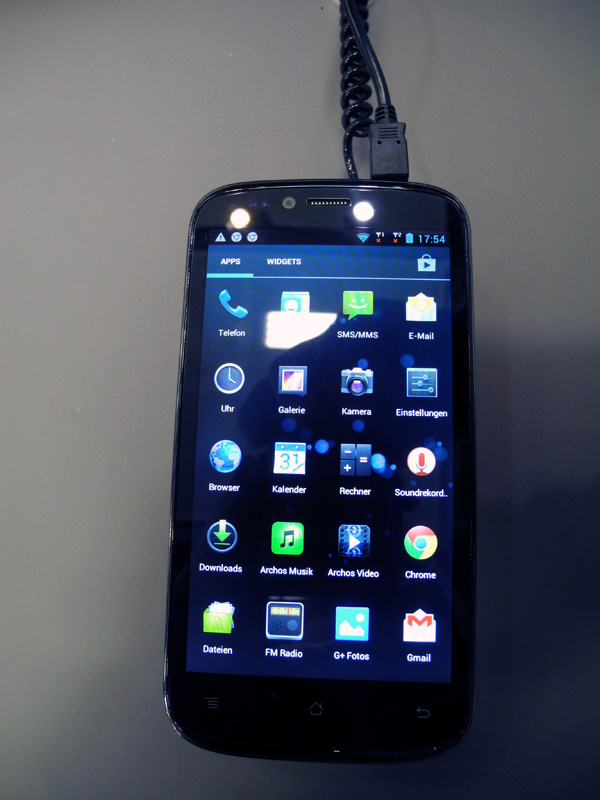
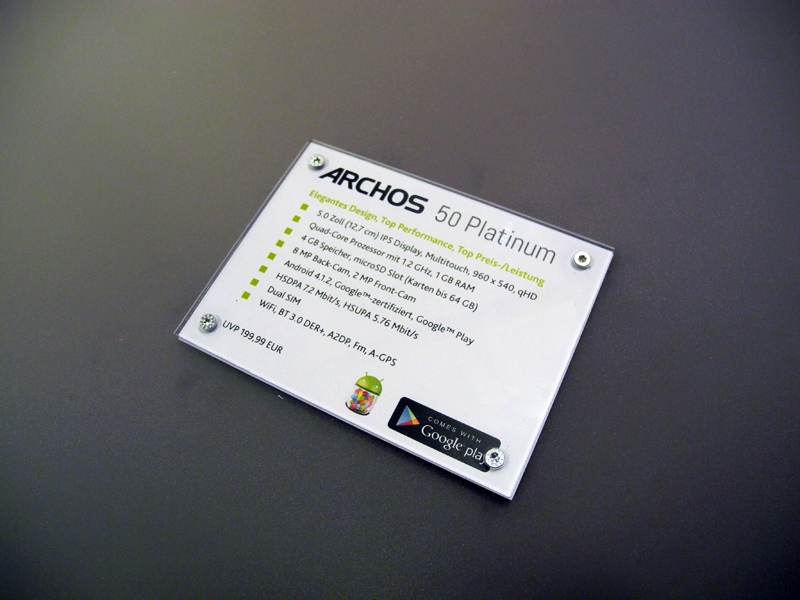
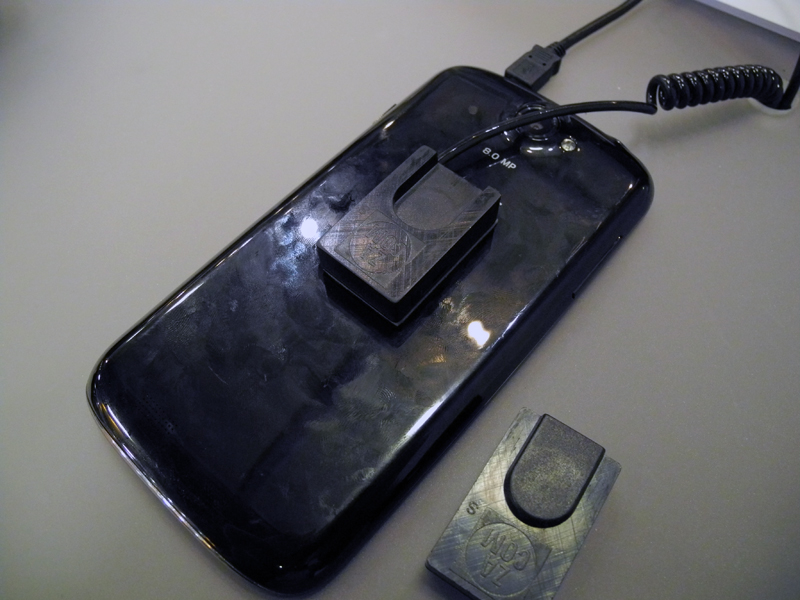
What plans does a European consumer company take? Price? I would not say. The Archos 50 Platinum and 53 Platinum shown in the photo above are estimated at 200 and 250 euros, respectively ...
On such a minor note, I complete the first part of the review of the mobile novelties of the IFA. In the next part I will focus in detail on the novelties of Russian companies - Texet, IconBIT, Wexler.

Samsung
Samsung pavilion was expected to be the biggest at IFA 2013, with its own stage and many themed stands. According to my calculations, only Samsung Galaxy Note 3 was put up at least 200 pieces!
')

There were a lot of people with these smartphones, but because of the large number of exhibited copies, anyone who wanted could literally immediately hold a novelty in their hands.
Galaxy Note 3
And I must say, I liked the device. Workmanship - at a height.

The metal strip around the perimeter is corrugated, apparently, this is done so that the device clings even more to the palm. By the way, I did not experience any discomfort from the size of the smartphone, perhaps because of the considerable size of my hand. But with the Sony Xperia ZU is really really difficult to manage.







Galaxy Note 3 has several color options, and they differ markedly in the finishing of the front panel. For example, the design of the front panel of the dark gray version gives rise to associations with brushed aluminum, and in the white and pink versions the pattern is already geometric - diamonds with stripes.







Earlier, I had to deal with Samsung smartphones, but the Galaxy Note 3, in my opinion, is the first, the metal design elements of which really look like metal ones, you can’t confuse them with “silvered plastic” even in appearance. They are made very carefully, especially liked the metal mesh of the speaker on the bottom, slightly protruding metal plate covering the auditory speaker, and the one-piece swing volume control. Finally, Samsung does not look cheap!
Partly "expensive" view is achieved through the back cover, which is really made of leather. Extremely interesting decision, but is it practical? The fact is that going up to the white tablet Galaxy Note 10.1, the back panel of which is also trimmed with leather, I was unpleasantly surprised by the black stains on it. Notice that the exhibition samples rested on leather (!) Stands and were securely fixed, i.e. just did not fall. It turns out that the skin so quickly got dirty just because of dirty hands? And what will happen if you throw a smartphone or tablet on the bottom of the bag or backpack? And if you constantly wear it there? Already at home or in a car, the device will obviously not be lying on a clean white leather counter, as it was at the exhibition ...

Naturally, you can gently handle the cover, and all the dirt will come down, but my opinion is this: in a mobile device, constantly carried with you, the skin gives way to plastic in practicality. How long it will last in the white and pink versions is a big question. In this case, it is better to buy a dark gray Galaxy Note 3, traces of dirt on dark skin will not be noticeable for a very, very long time.
Galaxy Note 3 has an LED event indicator. It is hidden under the front panel and is lit with diffused light. It turns out to be funny: at first you want to “put the focus on”, you squint, and only then you realize that “sharpness” is not initially provided for. Like, "fishechka" such.

Speaking of the Samsung Galaxy Note 3 can not be said about the covers, released specifically for him. I also liked them very much, and this is what: the back wall of the smartphone so tightly adheres to the wall of the case that it seems as if the smartphone and the case are one. For several seconds I tried to find the place where the cover and the smartphone were connected! And after all, the back wall of the cover is exactly like the lid of a smartphone, not to distinguish it! Developers for such a "close relationship" Galaxy Note 3 and a protective device - five points.




Samsung Galaxy Note 3. Software and settings.
















But let's move on from the appearance to the performance of the Samsung Galaxy Note 3. I managed to install on the version with LTE support (ie, on the Qualcomm Snapdragon 800 MSM8974 platform) and drive only two benchmarks: AnTuTu and NenaMark 2. The results are lower.



Obviously, the performance of the Galaxy Note 3 is high, and the Qualcomm Snapdragon 800 is strong. But how much? I tried to answer this question just below (see Toshiba section).
Galaxy gear
After the Galaxy Note 3, I immediately switched to the Galaxy Gear watch, which Samsung is very proud of.

In my opinion, there is nothing to be proud of. The device turned out heavy and rather cumbersome. Several girls, who had been looking at the clock next to me for a long time, talked about the same thing - Samsung had got very big watches. And this is despite the fact that Galaxy Gear is focused more on the female audience than on the male. Here is such a feedback from the target audience ...





By the way, Galaxy Gear was hardly fastened on my hand. Another hint that they are not for the male hand?


And it was also inconvenient for me to control the touch display. The screen is small, and if the fingers are large, then, for example, in the settings, when the screen displays three bars of sub-menu items, you should aim exactly at the middle of each sub-item, otherwise it is very likely to perform the very action that you planned. Maybe I just didn’t have time to get used to this particular watch, but, on the other hand, why would a person, “rolling away” half the cost of Galaxy Note 3 for Galaxy Gear, have to get used to something else? Why did I almost immediately figure out how to manage iPod nano, but I couldn’t master Galaxy Gear in 10-15 minutes? Certainly not because he did not want. In a word, I would advise Koreans to work on the interface yet. Template Android with its menus, in my opinion, is not suitable for such a device, the system must be seriously modified.








By the way, there is only one button in the watch, and this also does not make working with a wearable computer, which is Galaxy Gear, easier.
On one side of the watch in the peculiar tide area is a camera eye.




This arrangement makes it Galaxy Gear an excellent device for conducting "spy" shooting - see the video below: the girls standing nearby did not even notice that I was shooting them!
But for communication, it would be more logical to place the camera on the front panel, because anyone wearing a watch looks at the screen, not at the strap. Why did Samsung decide to make a garden with this strap, it is completely incomprehensible to me.
Finally, software. Watch the video below, it gives a complete picture of what the Galaxy Gear software component is.
I have to say that I didn’t like the Samsung watch at all, either by the performance or the look. I did not see anything in them that the Koreans could be proud of or at least brag about. Additional functions (such as a pedometer) are secondary, some of the main ones (here I mean, in the first place, the fish-eye of the camera) are implemented coarsely, the menu is completely intuitive. I remember well when in 2009 I saw the LG GD910 watch - then they made an effect on me. But now, after four (!) Years, Samsung, in fact, offers the same thing. And not just offers, presents it with great pomp! Like, we worked out, we worked, everything was for you. Casual mentioning at the same time that Galaxy Gear, firstly, is helpless without a smartphone, and secondly, so far compatible only with Galaxy Note 3 and Galaxy S 4. By God, it’s funny and sad. The same Sony does not make any hype out of its watches, which meanwhile have grown to the second generation, and I like this approach a lot more. Not to mention the Pebble.
In short, I tend to call the Galaxy Gear a big mistake of Samsung. Perhaps it is understood in the company, otherwise where did the rumors that this device will never go on sale, but instead a half-finished copy of the Galaxy Gear 2 will appear in six months?
Galaxy Note 10.1 2013 Edition
This tablet is correctly called the stretched version of the Galaxy Note 3: the design, adjusted for size, is exactly the same.



The new Galaxy Note 10.1 was presented in two colors: white and black. The second option I liked more due to the design of the front panel with sparkles, which "plays" in the light.


It makes no sense to describe the tablet in detail: everything that was said about Galaxy Note 3 applies to it.



Toshiba
At IFA 2013, I discovered Toshiba tablets - I had never come across them before. I must admit, I liked the entire line of tablets of the Japanese company, but it is difficult to explain why. They do not represent anything outstanding in terms of design, software is also of the same type, as an example you can put only a clear division into niches and price groups (the flagship model is Excite Pro, the budget one is Excite Pure, some intermediate variant is Excite Write providing pen input) and modern characteristics (in Excite Pro and Retina display, and HDMI output is).
The greatest interest, of course, was Excite Pro, built on the NVIDIA Tegra 4 platform. Its characteristics, as well as some layout features, can be seen in the photo below.




And now - about performance. I was able to run the device in three benchmarks: AnTuTu, Quadrant and Vellamo.




In the context of comparison with Qualcomm Snapdragon 800 in Galaxy Note 3, the most interesting result is Excite Pro in AnTuTu. Immediately I will note that in the tablet used so-called. Retina screen with a resolution of 2560 x 1600 pixels, and the Samsung smartphone uses “regular” Full HD, so the load on the Tegra 4 GPU was a priori higher. In order not to run my eyes on two photos, I summarized all the data in one tablet.
| Qualcomm Snapdragon 800 (Samsung Galaxy Note 3) | Test | NVIDIA Tegra 4 (Toshiba Excite Pro) |
|---|---|---|
| 29741 | Total score | 30074 |
| 5271 | Multitask | 7479 |
| 3507 | Dalvik | 2628 |
| 1685 | CPU Integer | 3435 |
| 2008 | CPU float-point | 4155 |
| 824 | RAM Operation | 1615 |
| 2457 | Ram speed | 1845 |
| 1638 | 2D graphics | 1375 |
| 9908 | 3D Graphics | 5831 |
| 1763 | Storage I / O | 1091 |
| 680 | Database I / O | 630 |
Tsiferki speak for themselves: in terms of CPU performance, NVIDIA Tegra 4 bypasses Qualcomm Snapdragon 800. With the GPU, the situation is not so straightforward, but it seems to me that if the tablet had a Full HD screen, then the graphics performance would be about the same level. Indirectly, this is confirmed by the fact that in the 2D graphics test NVIDIA Tegra 4 lost less than in the 3D test.
The only thing I didn’t like in Toshiba Excite Pro (and also not in many Chinese tablets) is the use of a separate charge instead of the usual microUSB cable.

In the satellites Excite Pro, the Japanese company offers a keyboard case.

Panasonic
The highlight of the Panasonic booth was a 20-inch tablet with a 4K resolution, announced at the beginning of the year. The device is called - 4K Tablet.

The device uses an IPS Alpha panel with a 15:10 aspect ratio and a resolution of 3840 x 2560 pixels. With a diagonal size of 20 inches, the pixel density does not seem at all impressive - only 230 ppi.

In the list of characteristics of the tablet - Intel Core i5-3437U 1.9 GHz processor, NVIDIA GeForce 745M graphics card, 4 or 8 GB DDR3 RAM, 128 or 256 GB SSD, Wi-Fi 802.11a / b / g / n adapters and Bluetooth 4.0, one USB 3.0 port, one SDXC slot. There is also a dock connector. For 4K Tablet surcharge, you can equip Anoto Pen with a digital pen and support for smart cards.

It was impossible to work with the tablet, access to the system was blocked. In fact, it remained to either consider beautiful pictures, or evaluate the work of the pen. However, I have something to note. First, the device screen is really good. But it is obvious, but more ...

4K Tablet is a kind of layout miracle. Judge for yourself: the case is thin, like a tablet, components - like a traditional laptop, the screen in general (so far) - is not of this world. As a result, there are lots of nuances. The device turned out to be quite heavy and not at all so portable as to carry it every day from home to work. Well, suppose it will lie on the table all the time, but then access to the connectors located on the sides is noticeably worse. And if the flash drive is still inserted, it may turn out (and then only if it is not thick), then it will be problematic to stick the memory card. I'm not even talking about the fact that in the “flat” position both ventilation openings and speaker slots will be blocked.




Another questionable, in my opinion, solution is the placement of LED indicators on the beveled part of the left side panel. Again, if the tablet rests on a horizontal surface, these LEDs will flicker ... on the table. And to judge the status of the drive, memory card, power circuit can be except for the gleam. Why not bring them to the front of the device is not clear.

And I also think that for such a large device, the claimed battery life - about 2 hours - is not enough. But this is already so, little things.
In general, while I do not see at 4K Tablet broad commercial prospects. At least in the current performance. Yes, it is possible that the device will be ordered by renowned design studios and architectural studios, but this demand will be satisfied. On the other hand, someone should be the first, and the first pancake ... Well, you know.
TCL / Alcatel
The Chinese company TCL "shot" on the IFA flagship smartphone Alcatel One Touch Hero.


On the one hand, the characteristics of the device are really good - a 6-inch Full HD OGS screen with an olymphobic coating, a 13 megapixel camera, 2 GB of RAM, on the other - multitouch only 5 touches, the built-in flash memory reaches a maximum of 16 GB. In short, the flagship remains the flagship, but in its own, budget category.

The assembly of the device is excellent, the panels fit tightly to each other. If the exhibition samples were so well made, it can be expected that the level of production of commodity devices will be at least as good. The device lies well in the hand, but its large size makes it impossible to operate with one hand. In fairness it should be noted that the developers have taken care of the ability to control certain functions of the device using gestures.






The back panel of the Alcatel One Touch Hero is made of high-quality matte soft touch plastic, on which virtually no fingerprints remain.

Unfortunately, the test of the smartphone did not work, at the TCL stand either it didn’t work, or the Internet was turned off. However, I have absolutely no doubt that this smartphone uses the MediaTek MT6589T platform, the capabilities of which are well known.
Next to Alcatel One Touch Hero, MagicFlip accessories designed specifically for the flagship model were exhibited: a cover with a built-in LED screen, a cover with an E Ink screen and a cover that provides wireless battery charging.


Another premiere of TCL at IFA is the Alcatel Pop C series of low-cost smartphones: C1, C3, C5 and C7. I would call this a kind of answer to the line of low-cost smartphones LG Optimus L, in which there are models L1, L3, L5, L7 and L9. Agree, it is unlikely that such a coincidence of names can be considered random. Especially after the idea of the release of the LG Optimus L proved to be effective high sales.
Actually, there is nothing special to talk about Pop C: multi-colored devices are a plus, but the case materials are extremely inexpensive, and the design is expressionless - these are minuses. Characteristics correspond to the budget class.



The only Alcatel tablet on display — the One Touch Evo 8 HD — didn’t like the look. First, the colors of the covers: they are somehow flashy and "stretched". Secondly, with materials: the soiled gloss of the front panel “excellent” is complemented by a brand and a slippery back panel. The screen brightness seemed to me insufficient.



According to the software of the Alcatel One Touch Evo 8 HD - nothing interesting, the tablet is running Android 4.2. The technical characteristics are also nothing outstanding: a dual-core Rockchip RK3066 1.6 GHz processor, an IPS screen with a diagonal of 8 inches and a resolution of 1024 x 768 pixels, 1 GB of RAM, 4 GB of flash memory, cameras with a resolution of 2 and 3 megapixels. I am glad that the battery capacity is an impressive 4150 mAh. It should be assumed that the autonomy of this device is complete order.


Archos
Once upon a time, when the tablets had not yet done everything, I was staring at the Archos products, then they seemed to me just cosmic. The time has passed, the industry has changed, Archos has begun to produce smartphones ... And now I would really like to turn back time, because the company showed at IFA how not to make smartphones.

The line of "smart phones" Archos consists of three series - Titanium, Platinum and Oxygen, in which consumers are offered eight models. The first series includes low-end devices, the representatives of the second are characterized by “elegant design and top performance”, and the “oxygen” smartphones (as long as the line is represented by only one model), by definition, developers should be fast, productive and affordable.
I started to get acquainted with the devices of the Platinum series, and I finished them. Why? Because after the second device, Archos did not want to take the smartphones in hand. I got the feeling that the company, taking advantage of a fairly well-promoted brand in Europe, decided to ship the cheapest Chinese OEM to the Old World market. Obviously, they saved on everything: on equipment (see characteristics in the photo below), and on finishing materials. Last frankly upset Mark gloss is used in the design of the front panel and the back. And just make - it is mildly said! Fitting the hull halves is unimportant, there are elevators. Finally, the design of the Archos smartphones is simply absent.





What plans does a European consumer company take? Price? I would not say. The Archos 50 Platinum and 53 Platinum shown in the photo above are estimated at 200 and 250 euros, respectively ...
On such a minor note, I complete the first part of the review of the mobile novelties of the IFA. In the next part I will focus in detail on the novelties of Russian companies - Texet, IconBIT, Wexler.
Source: https://habr.com/ru/post/195024/
All Articles